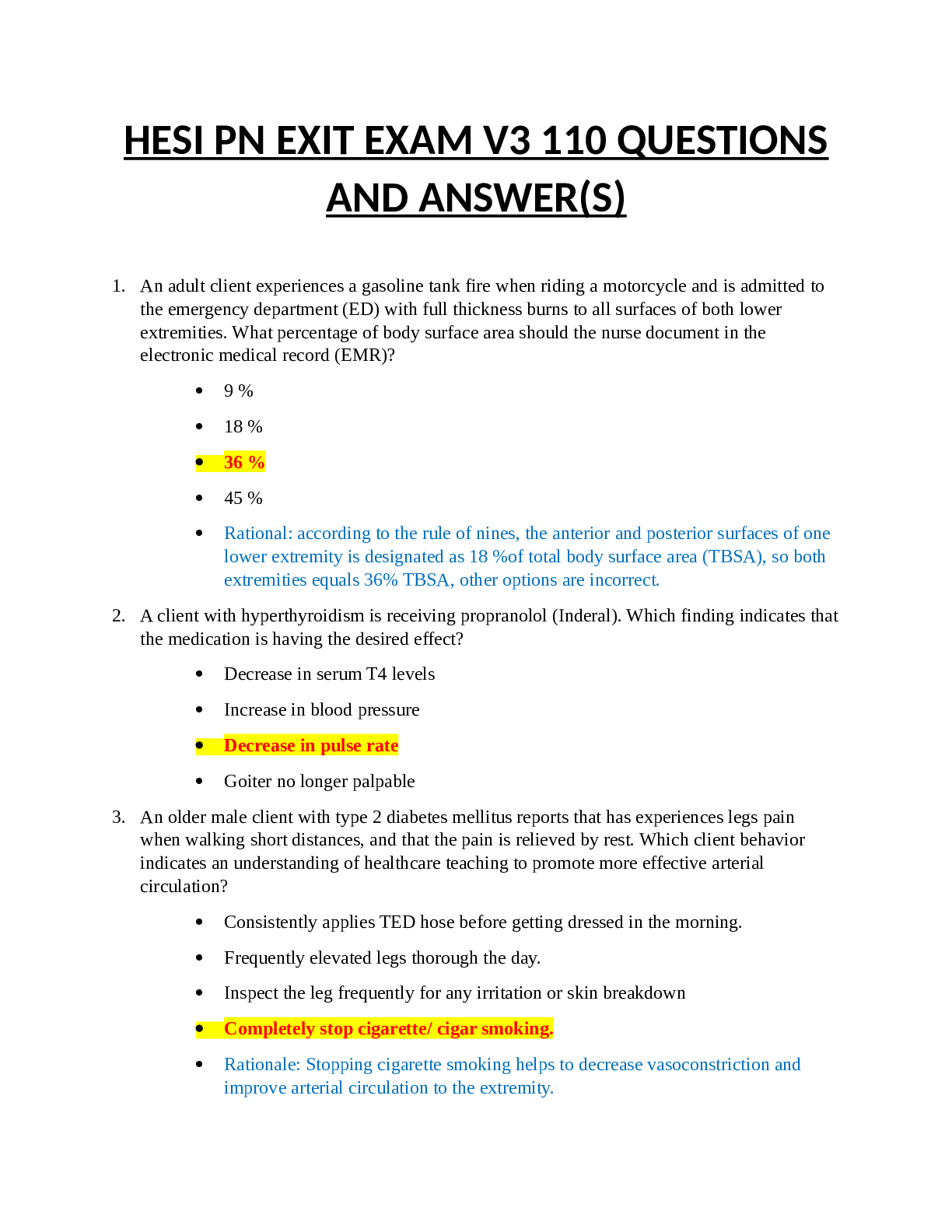HESI V3 PN EXIT EXAM 110 QUESTIONS AND ANSWER (100%) CORRECT
Document Content and Description Below
HESI V3 PN EXIT EXAM 110 QUESTIONS AND ANSWER (100%) CORRECT-An adult client experiences a gasoline tank fire when riding a motorcycle and is admitted to the emergency department (ED) with full thickn... ess burns to all surfaces of both lower extremities. What percentage of body surface area should the nurse document in the electronic medical record (EMR)? • 9 % • 18 % • 36 % • 45 % • Rational: according to the rule of nines, the anterior and posterior surfaces of one lower extremity is designated as 18 %of total body surface area (TBSA), so both extremities equals 36% TBSA, other options are incorrect. 2. A client with hyperthyroidism is receiving propranolol (Inderal). Which finding indicates that the medication is having the desired effect? • Decrease in serum T4 levels • Increase in blood pressure • Decrease in pulse rate • Goiter no longer palpable 3. An older male client with type 2 diabetes mellitus reports that has experiences legs pain when walking short distances, and that the pain is relieved by rest. Which client behavior indicates an understanding of healthcare teaching to promote more effective arterial circulation? • Consistently applies TED hose before getting dressed in the morning. • Frequently elevated legs thorough the day. • Inspect the leg frequently for any irritation or skin breakdown • Completely stop cigarette/ cigar smoking. • Rationale: Stopping cigarette smoking helps to decrease vasoconstriction and improve arterial circulation to the extremity. 4. A community health nurse is concerned about the spread of communicable diseases among migrant farm workers in a rural community. What action should the nurse take to promote the success of a healthcare program designed to address this problem? • Establish trust with community leaders and respect cultural and family values 5. The nurse performs a prescribed neurological check at the beginning of the shift on a client who was admitted to the hospital with a subarachnoid brain attack (stroke). The client’s Glasgow Coma Scale (GCS) score is 9. What information is most important for the nurse to determine? • The client’s previous GCS score • When the client’s stroke symptoms started • If the client is oriented to time • The client’s blood pressure and respiration rate • Rationale: The normal GCS is 15, and it is most important for the nurse to determine if it abnormal score a sign of improvement or a deterioration in the client’s condition 6. The charge nurse in a critical care unit is reviewing clients’ conditions to determine who is stable enough to be transferred. Which client status report indicates readiness for transfer from the critical care unit to a medical unit? • Chronic liver failure with a hemoglobin of 10.1 and slight bilirubin elevation 7. Based on principles of asepsis, the nurse should consider which circumstance to be sterile? • One inch- border around the edge of the sterile field set up in the operating room • A wrapped unopened, sterile 4x4 gauze placed on a damp table top. • An open sterile Foley catheter kit set up on a table at the nurse waist level • Sterile syringe is placed on sterile area as the nurse riches over the sterile field. • Rationale: A sterile package at or above the waist level is considered sterile. The edge of sterile field is contaminated which include a 1-inch border (A). A sterile objects become contaminated by capillary action when sterile objects become in contact with a wet contaminated surface. 8. An unlicensed assistive personnel (UAP) reports that a client’s right hand and fingers spasms when taking the blood pressure using the same arm. After confirming the presence of spams what action should the nurse take? • Ask the UAP to take the blood pressure in the other arm • Tell the UAP to use a different sphygmomanometer. • Review the client’s serum calcium level • Administer PRN antianxiety medication. • Rationale: Trousseau’s sign is indicated by spasms in the distal portion of an extremity that is being used to measure blood pressure and is caused by hypocalcemia (normal level 9.0-10.5 mg/dl, so C should be implemented. 9. A 56-years-old man shares with the nurse that he is having difficulty making decision about terminating life support for his wife. What is the best initial action by the nurse? • Provide an opportunity for him to clarify his values related to the decision • Encourage him to share memories about his life with his wife and family • Advise him to seek several opinions before making decision • Offer to contact the hospital chaplain or social worker to offer support. • Rationale: When a client is faced with a decisional conflict, the nurse should first provide opportunities for the client to clarify values important in the decision. The rest may also be beneficial once the client as clarified the values that are important to him in the decision-making process. 10. A client is being discharged home after being treated for heart failure (HF). What instruction should the nurse include in this client’s discharge teaching plan? • Weigh every morning • Eat a high protein diet • Perform range of motion exercises • Limit fluid intake to 1,500 ml daily 11. A woman just learned that she was infected with Heliobacter pylori. Based on this finding, which health promotion practice should the nurse suggest? • Encourage screening for a peptic ulcer 12. A client who recently underwear a tracheostomy is being prepared for discharge to home. Which instructions is most important for the nurse to include in the discharge plan? • Teach tracheal suctioning techniques 13. A child with heart failure is receiving the diuretic furosemide (Lasix) and has serum potassium level 3.0 mEq/L. Which assessment is most important for the nurse to obtain? • Cardiac rhythm and heart rate. • Daily intake of foods rich in potassium. • Hourly urinary output • Thirst ad skin turgor. 14. The nurse note a depressed female client has been more withdrawn and non-communicative during the past two weeks. Which intervention is most important to include in the updated plan of care for this client? • Encourage the client’s family to visit more often • Schedule a daily conference with the social worker • Encourage the client to participate in group activities • Engage the client in a non-threatening conversation. • Rationale: Consistent attempts to draw the client into conversations which focus on non-threatening subjects can be an effective means of eliciting a response, thereby decreasing isolation behaviors. There is not sufficient data to support the effectiveness of A as an intervention for this client. Although B may be indicated, nursing interventions can also be used to treat this client. C is too threatening to this client. 15. A client with rheumatoid arthritis (RA) starts a new prescription of etanercept (Enbrel) subcutaneously once weekly. The nurse should emphasize the importance of reporting problem to the healthcare provider? • Headache • Joint stiffness • Persistent fever • Increase hunger and thirst • Rationale: Enbrel decrease immune and inflammatory responses, increasing the client’s risk of serious infection, so the client should be instructed to report a persistent fever, or other signs of infection to the healthcare provider. 16. The nurse is assessing an older adult with type 2 diabetes mellitus. Which assessment finding indicates that the client understands long- term control of diabetes? • The fating blood sugar was 120 mg/dl this morning. • Urine ketones have been negative for the past 6 months • The hemoglobin A1C was 6.5g/100 ml last week • No diabetic ketoacidosis has occurred in 6 months. • Rationale: A hemoglobin A1C level reflects he average blood sugar the client had over the previous 2 to 3 month, and level of 6.5 g/100 ml suggest that the client understand long-term diabetes control. Normal value in a diabetic patient is up to 6.5 g/100 ml. 17. An older male client is admitted with the medical diagnosis of possible cerebral vascular accident (CVA). He has facial paralysis and cannot move his left side. When entering the room, the nurse finds the client’s wife tearful and trying unsuccessfully to give him a drink of water. What action should the nurse take? • Ask the wife to stop and assess the client’s swallowing reflex 18. A 13 years-old client with non-union of a comminuted fracture of the tibia is admitted with osteomyelitis. The healthcare provider collects home aspirate specimens for culture and sensitivity and applies a cast to the adolescent’s lower leg. What action should the nurse implement next? • Administer antiemetic agents • Bivalve the cast for distal compromise • Provide high- calorie, high-protein diet • Begin parenteral antibiotic therapy • Rationale: The standard of treatment for osteomyelitis is antibiotic therapy and immobilization. After bond and blood aspirate specimens are obtained for culture and sensitivity, the nurse should initiate parenteral antibiotics as prescribed. 19. The nurse is preparing a community education program on osteoporosis. Which instruction is helpful in preventing bone loss and promoting bone formation? • Recommend weigh bearing physical activity 20. A client with a history of chronic pain requests a nonopioid analgesic. The client is alert but has difficulty describing the exact nature and location of the pain to the nurse. What action should the nurse implement next? • Administer the analgesic as requested 21. A male client receives a thrombolytic medication following a myocardial infarction. When the client has a bowel movement, what action should the nurse implement? • Send stool sample to the lab for a guaiac test • Observe stool for a day-colored appearance. • Obtain specimen for culture and sensitivity analysis • Asses for fatty yellow streaks in the client’s stool. • Rationale: Thrombolytic drugs increase the tendency for bleeding. So guaiac (occult blood test) test of the stool should be evaluated to detect bleeding in the intestinal tract. 22. The mother of a child with cerebral palsy (CP) ask the nurse if her child’s impaired movements will worsen as the child grows. Which response provides the best explanation? • Brain damage with CP is not progressive but does have a variable course 23. During shift report, the central electrocardiogram (EKG) monitoring system alarms. Which client alarm should the nurse investigate first? • Respiratory apnea of 30 seconds 24. In early septic shock states, what is the primary cause of hypotension? • Peripheral vasoconstriction • Peripheral vasodilation • Cardiac failure • A vagal response • Rationale: Toxins released by bacteria in septic shock create massive peripheral vasodilation and increase microvascular permeability at the site of the bacterial invasion. 25. A client diagnosed with calcium kidney stones has a history of gout. A new prescription for aluminum hydroxide (Amphogel) is scheduled to begin at 0730. Which client medication should the nurse bring to the healthcare provider’s attention? • Allopurinol (Zyloprim) • Aspirin, low dose • Furosemide (lasix) • Enalapril (vasote) 26. A male client’s laboratory results include a platelet count of 105,000/ mm3 Based on this finding the nurse should include which action in the client’s plan of care? • Cluster care to conserve energy • Initiate contact isolation • Encourage him to use an electric razor • Asses him for adventitious lung sounds • Rationale: This client is at risk for bleeding based on his platelet count (normal 150,000 to 400,000/ mm3). Safe practices, such as using an electric razor for shaving, should be encouraged to reduce the risk of bleeding. 27. A client is admitted to the hospital after experiencing a brain attack, commonly referred to as a stroke or cerebral vascular accident (CVA). The nurse should request a referral for speech therapy if the client exhibits which finding? • Abnormal responses for cranial nerves I and II • Persistent coughing while drinking • Unilateral facial drooping • Inappropriate or exaggerated mood swings 28. At 1615, prior to ambulating a postoperative client for the first time, the nurse reviews the client’s medical record. Based on date contained in the record, what action should the nurse take before assisting the client with ambulation: • Remove sequential compression devices. • Apply PRN oxygen per nasal cannula. • Administer a PRN dose of an antipyretic. • Reinforce the surgical wound dressing. • Rationale: Sequential compression devices should be removed prior to ambulation and there is no indication that this action is contraindicated. The client’s oxygen saturation levels have been within normal limits for the previous four hours, so supplemental oxygen is not warranted. 29. Which assessment finding for a client who is experiencing pontine myelinolysis should the nurse report to the healthcare provider? • Sudden dysphagia • Blurred visual field • Gradual weakness • Profuse diarrhea 30. A client is scheduled to receive an IW dose of ondansetron (Zofran) eight hours after receiving chemotherapy. The client has saline lock and is sleeping quietly without any restlessness. The nurse caring for the client is not certified in chemotherapy administration. What action should the nurse take? • Ask a chemotherapy-certified nurse to administer the Zofran • Administer the Zofran after flushing the saline lock with saline • Hold the scheduled dose of Zofran until the client awakens • Awaken the client to assess the need for administration of the Zofran. • Rationale: Zofran is an antiemetic administered before and after chemotherapy to prevent vomiting. The nurse should administer the antiemetic using the accepter technique for IV administration via saline lock. Zofran is not a chemotherapy drug and does not need to be administered by a chemotherapy- certified nurse. 31. When providing diet teaching for a client with cholecystitis, which types of food choices the nurse recommend to the client? • High protein • Low fat • Low sodium • High carbohydrate. • Rationale: A client with cholecystitis is at risk of gall stones that can be move into the biliary tract and cause pain or obstruction. Reducing dietary fat decrease stimulation of the gall bladder, so bile can be expelled, along with possible stones, into the biliary tract and small intestine. 32. A client with a history of cirrhosis and alcoholism is admitted with severe dyspnea and ascites. Which assessment finding warrants immediate intervention by the nurse? • Jaundice skin tone • Muffled heart sounds • Pitting peripheral edema • Bilateral scleral edema • Rationale: Muffled heart sounds may indicative fluid build-up in the pericardium and is life- threatening. The other one are signs of end stage liver disease related to alcoholism but are not immediately life- threatening. 33. When entering a client’s room, the nurse discovers that the client is unresponsive and pulseless. The nurse initiate CPR and Calls for assistance. Which action should the nurse take next? • Prepare to administer atropine 0.4 mg IVP • Gather emergency tracheostomy equipment • Prepare to administer lidocaine at 100 mg IVP • Place cardiac monitor leads on the client’s chest. • Rationale: Before further interventions can be done, the client’s heart rhythm must be determined. This can be done by connecting the client to the monitor. A or C are not a first line drug given for any of the life threatening, pulses dysrhythmias 34. A client with a history of dementia has become increasingly confused at night and is picking at an abdominal surgical dressing and the tape securing the intravenous (IV) line. The abdominal dressing is no longer occlusive, and the IV insertion site is pink. What intervention should the nurse implement? • Replace the IV site with a smaller gauge. • Redress the abdominal incision • Leave the lights on in the room at night. • Apply soft bilateral wrist restraints. • Rationale: The abdominal incision should be redressed using aseptic-techniques. The IV site should be assessed to ensure that it has not been dislodged and a dressing reapplied, if need it. Leaving the light on at night may interfere with the client’s sleep and increase confusion. Restraints are not indicated and should only be used as a last resort to keep client from self-harm. 35. An adult male client is admitted to the emergency room following an automobile collision in which he sustained a head injury. What assessment data would provide the earliest that the client is experiencing increased intracranial pressure (ICP)? • Lethargy • Decorticate posturing • Fixed dilated pupil • Clear drainage from the ear. • Rationale: Lethargy is the earliest sign of ICP along with slowing of speech and response to verbal commands. The most important indicator of increase ICP is the client’s level or responsiveness or consciousness. B and C are very late signs of ICP. 36. In preparing a diabetes education program, which goal should the nurse identify as the primary emphasis for a class on diabetes self-management? • Prepare the client to independently treat their disease process • Reduce healthcare costs related to diabetic complications • Enable clients to become active participating in controlling the disease process • Increase client’s knowledge of the diabetic disease process and treatment options. • Rationale: The primary goal of diabetic self- management education is to enable the client to become an active participant in the care and control of disease process, matching levels of self- management to the abilities of the individual client. The goal is to place the client in a cooperative or collaborative role with healthcare professional rather than (A) 37. To reduce staff nurse role ambiguity, which strategy should the nurse manager implemented? • Confirm that all the staff nurses are being assigned to equal number of clients. • Review the staff nurse job description to ensure that it is clear, accurate, and recurrent. • Assign each staff nurse a turn unit charge nurse on a regular, rotating basis. • Analyze the amount of overtime needed by the nursing staff to complete assignments. • Rationale: Role ambiguity occurs when there is inadequate explanation of job descriptions and assigned tasks, as well as the rapid technological changes that produce uncertainty and frustration. A and D may be implemented if the nurse manager is concerned about role overload, which is the inability to accomplish the tasks related to one’s role. C is not related to ambiguity. 38. The nurse is assisting a new mother with infant feeding. Which information should the nurse provide that is most likely to result in a decrease milk supply for the mother who is breastfeeding? • Supplemental feedings with formula • Maternal diet high in protein • Maternal intake of increased oral fluid • Breastfeeding every 2 or 3 hours. • Rationale: Infant sucking at the breast increases prolactin release and proceeds a feedback mechanism for the production of milk, the nurse should explain that supplemental bottle formula feeding minimizes the infant’s time at the breast and decreases milk supply. B promotes milk production and healing after delivery. C support milk production. C is recommended routine for breast feeding that promote adequate milk supply. 39. Which assessment is more important for the nurse to include in the daily plan of care for a client with a burned extremity? • Range of Motion • Distal pulse intensity • Extremity sensation • Presence of exudate • Rationale: Distal pulse intensity assesses the blood flow through the extremity and is the most important assessment because it provides information about adequate circulation to the extremity. Range of motions evaluates the possibility of long term contractures sensation. C evaluates neurological involvement, and exudate. D provides information about wound infection, but this assessment do not have the priority of determining perfusion to the extremity. 40. An elderly client with degenerative joint disease asks if she should use the rubber jar openers that are available. The nurse’s response should be based on which information about assistive devices? • They decrease the risk for joint trauma 41. When assessing a 6-month old infant, the nurse determines that the anterior fontanel is bulging. In which situation would this finding be most significant? • Crying • Straining on stool • Vomiting • Sitting upright. • Rationale: The anterior fontanel closes at 9 months of age and may bulge when venous return is reduced from the head, but a bulging anterior fontanel is most significant if the infant is sitting up and may indicated an increase in cerebrospinal fluid. Activities that reduce venous return from the head, such as crying, a Valsalva maneuver, vomiting or a dependent position of the head, cause a normal transient increase in intracranial pressure. 42. A client with angina pectoris is being discharge from the hospital. What instruction should the nurse plan to include in this discharge teaching? • Engage in physical exercise immediately after eating to help decrease cholesterol levels. • Walk briskly in cold weather to increase cardiac output • Keep nitroglycerin in a light-colored plastic bottle and readily available. • Avoid all isometric exercises, but walk regularly. • Rationale: Isometric exercise can raise blood pressure for the duration of the exercise, which may be dangerous for a client with cardiovascular disease, while walking provides aerobic conditioning that improves ling, blood vessel, and muscle function. Client with angina should refrain from physical exercise for 2 hours after meals, but exercising does not decrease cholesterol levels. Cold water cause vasoconstriction that may cause chest pain. Nitroglycerin should be readily available and stored in a dark-colored glass bottle not C, to ensure freshness of the medication. 43. What is the priority nursing action when initiating morphine therapy via an intravenous patient-controlled analgesia (PCA) pump? • Initiate the dosage lockout mechanism on the PCA pump • Instruct the client to use the medication before the pain becomes severe • Assess the abdomen for bowel sounds. • Assess the client ability to use a numeric pain scale 44. While undergoing hemodialysis, a male client suddenly complains of dizziness. He is alert and oriented, but his skin is cool and clammy. His vital signs are: heart rate 128 beats/minute, respirations 18 breaths/minute, and blood pressure 90/60. Which intervention should the nurse implement first? • Raise the client’s legs and feet 45. The nurse receives a newborn within the first minutes after a vaginal delivery and intervenes to establish adequate respirations. What priority issue should the nurse address to ensure the newborn’s survival? • Heat loss • Hypoglycemia • Fluid balance • Bleeding tendencies 46. The fire alarm goes off while the charge nurse is receiving the shift report. What action should the charge nurse implement first? • Tell the staff to keep all clients and visitors in the client rooms with the doors closed 47. A 60-year-old female client asks the nurse about hormones replacement therapy (HRT) as a means preventing osteoporosis. Which factor in the client’s history is a possible contraindication for the use of HRT? • Her mother and sister have a history of breast cancer 48. A male client, who is 24 hours postoperative for an exploratory laparotomy, complains that he is “starving” because he has had no “real food” since before the surgery. Prior to advancing his diet, which intervention should the nurse implement? • Auscultate bowel sounds in all four quadrants 49. The nurse working in the psychiatric clinic has phone messages from several clients. Which call should the nurse return first? • A family member of a client with dementia who has been missing for five hours 50. During change of shift, the nurse reports that a male client who had abdominal surgery yesterday increasingly confused and disoriented during the night. He wandered into other clients rooms, saying that there are men in his room trying to hurt him. Because of continuing disorientation and the client’s multiple attempts to get of bed, soft restrains were applied at 0400. In what order should the nurse who is receiving report implement these interventions? (Arrange from first action on top to last on the bottom). 1. Assess the client’s skin and circulation for impairment related to the restrains 2. Evaluate the client’s mentation to determine need to continue the restrains 3. Assign unlicensed assistive personnel to remove restrains and remain with client 4. Contact the client’s surgeon and primary healthcare provider 51. A mother brings her 3-year-old son to the emergency room and tells the nurse the he has had an upper respiratory infection for the past two days. Assessment of the child reveals a rectal temperature of 102 F. he is drooling and becoming increasingly more restless. What action should the nurse take first? • Notify the healthcare provider and obtain a tracheostomy tray 52. After receiving the first dose of penicillin, the client begins wheezing and has trouble breathing. The nurse notifies the healthcare provider immediately and received several prescriptions. Which medication prescription should the nurse administer first? • Epinephrine Injection, USP IV 53. Two clients ring their call bells simultaneously requesting pain medication. What action should the nurse implement first? • Evaluate both client’s pain using a standardized pain scale 54. A client receives a new prescription for simvastatin (Zocor) 5 mg PO daily at bedtime. What action should the nurse take? • Administer the medication as prescribed with a glass of water 55. Which client should the nurse assess frequently because of the risk for overflow incontinence? A client • Who is confused and frequently forgets to go to the bathroom 56. While monitoring a client during a seizure, which interventions should the nurse implement? (Select all that apply) • Move obstacle away from client • Monitor physical movements • Observe for a patent airway • Record the duration of the seizure 57. A male client with a long history of alcoholism is admitted because of mild confusion and fine motor tremors. He reports that he quit drinking alcohol and stopped smoking cigarettes one month ago after his brother died of lung cancer. Which intervention is most important for the nurses to include in the client’s plan of care? • Determine client’s level current blood alcohol level. • Observe for changes in level of consciousness. • Involve the client’s family in healthcare decisions. • Provide grief counseling for client and his family. • Rationale: Based on the client’s history of drinking, he may be exhibiting sing of hepatic involvement and encephalopathy. Changes in the client’s level of consciousness should be monitored to determine if he able to maintain consciousness, so neurological assessment has the highest priority. 58. An older adult female admitted to the intensive care unit (ICU) with a possible stroke is intubated with ventilator setting of tidal volume 600, PlO2 40%, and respiratory rate of 12 breaths/minute. The arterial blood gas (ABG) results after intubation are PH 7.31. PaCO2 60, PaO2 104, SPO2 98%, HCO3 23. To normalize the client’s ABG finding, which action is required? • Report the results to the healthcare provider. • Increase ventilator rate. • Administer a dose of sodium carbonate. • Decrease the flow rate of oxygen. • Rationale: This client is experience respiratory acidosis. Increasing the ventilator rate depletes CO2 a, which returns the PH toward normal. Report findings is important but only after increasing ventilator rate. 59. The mother of the 12- month-old with cystic fibrosis reports that her child is experiencing increasing congestion despite the use of chest physical therapy (CPT) twice a day, and has also experiences a loss of appetite. What instruction should the nurse provide? • Perform CPT after meals to increase appetite and improve food intake. • CPT should be performed more frequently, but at least an hour before meals. • Stop using CPT during the daytime until the child has regained an appetite. • Perform CPT only in the morning, but increase frequency when appetite improves. • Rationale: CPY with inhalation therapy should be performed several times a day to loosen the secretions and move them from the peripheral airway into the central airways where they can be expectorated. CPT should be done at least one hour before meals or two hours after meals. 60. The nurse is evaluating the diet teaching of a client with hypertension. What dinner selection indicates that the client understands the dietary recommendation for hypertension? • Baked pork chop, applesauce, corn on the cob, 2% milk, and key-lime pie 61. A client with type 2 diabetes mellitus is admitted for frequent hyperglycemic episodes and a glycosylated hemoglobin (HbA1c) of 10%. Insulin glargine 10 units subcutaneously once a day at bedtime and a sliding scale with insulin aspart q6h are prescribed. What action should the nurse include in this client’s plan of care? • Fingerstick glucose assessment q6h with meals • Mix bedtime dose of insulin glargine with insulin aspart sliding scale dose • Review with the client proper foot care and prevention of injury • Do not contaminate the insulin aspart so that it is available for iv use • Coordinate carbohydrate controlled meals at consistent times and intervals • Teach subcutaneous injection technique, site rotation and insulin management 62. Which problem reported by a client taking lovastatin requires the most immediate fallow up by the nurse? • Diarrhea and flatulence • Abdominal cramps • Muscle pain • Altered taste • Rationale: statins can cause rhabdomyolysis, a potentially fatal disease of skeletal muscle characterized by myoglobinuria and manifested with muscle pain, so this symptom should immediately be reported to the HCP. 63. While assessing a client’s chest tube (CT), the nurse discovers bubbling in the water seal chamber of the chest tube collection device. The client’s vital signs are: blood pressure of 80/40 mmHg, heart rate 120 beats/minutes, respiratory rate 32 breaths/minutes, oxygen saturation 88%. Which interventions should the nurse implement? • Provide supplemental oxygen • Auscultate bilateral lung fields • Administer a nebulizer treatment • Reinforce occlusive CT dressing • Give PRN dose of pain medication • Rationale: the air bubbles indicate an air leak from the lungs, the chest tube site, or the chest tube collection system. Providing oxygen improves the oxygen saturation until the leak has been resolved. Auscultating the lung fields helps to identify absent or decrease lung sound due to collapsing lung. 64. Before leaving the room of a confused client, the nurse notes that a half bow knot was used to attach the client's wrist restraints to the movable portion of the client's bed frame. What action should the nurse take before leaving the room? • Ensure that the knot can be quickly released. • Tie the knot with a double turn or square knot. • Move the ties so the restraints are secured to the side rails. • Ensure that the restraints are snug against the client's wrist. 65. Oral antibiotics are prescribed for an 18-month-old toddler with severe otitis media. An antipyrine and benzocaine-otic also prescribed for pain and inflammation. What instruction should the nurse emphasize concerning the installation of the antipyrine/benzocaine otic solution? • Place the dropper on the upper outer ear canal and instill the medication slowly. • Warm the medication in the microwave for 10 seconds before instilling. • Keep the medication refrigerated between administrations. • Have the child lie with the ear up for one to two minute after installation. 66. An older adult male is admitted with complications related to chronic obstructive pulmonary disease (COPD). He reports progressive dyspnea that worsens on exertion and his weakness has increased over the past month. The nurse notes that he has dependent edema in both lower legs. Based on these assessment findings, which dietary instruction should the nurse provide? • Limit the intake of high calorie foods. • Eat meals at the same time daily. • Maintain a low protein diet. • Restrict daily fluid intake. • Rationale: the client is exhibiting signs of cor pulmonale, a complication of COPD that causes the right side of the heart to fail. Restricting fluid intake to 1000 to 2000 ml/day, eating a high-calorie diet at small frequent meals with foods that are high in protein and low in sodium can help relive the edema and decrease workload on the right-side of the heart. 67. The nurse inserts an indwelling urinary catheter as seen in the video what action should the nurse take next? • Remove the catheter and insert into urethral opening • Observe for urine flow and then inflate the balloon. • Insert the catheter further and observe for discomfort. • Leave the catheter in place and obtain a sterile catheter. • Rationale: the catheter is in the vaginal opening. 68. A client with coronary artery disease who is experiencing syncopal episodes is admitted for an electrophysiology study (EPS) and possible cardiac ablation therapy. Which intervention should the nurse delegate to the unlicensed assistive personnel (UAP)? • Prepare the skin for procedure. • Identify client's pulse points • Witness consent for procedure • Check telemetry monitoring 69. Fallowing an outbreak of measles involving 5 students in an elementary school, which action is most important for the school nurse to take? • Review the immunization records of all children in the elementary school • Report the measles outbreak to all community health organizations • Schedule a mobile public health vehicle to offer measles inoculations to unvaccinated children. • Restrict unvaccinated children from attending school until measles outbreak is resolved. 70. A preeclamptic client who delivered 24h ago remains in the labor and delivery recovery room. She continues to receive magnesium sulfate at 2 grams per hour. Her total input is limited to 125 ml per hour, and her urinary output for the last hour was 850 ml. What intervention should the nurse implement? • discontinue the magnesium sulfate immediately • Decrease the client's iv rate to 50 ml per hour • Continue with the plan of care for this client • Change the client's to NPO status • Rationale: continue with the plan. Diuresis in 24 to 48h after birth is a sign of improvement in the preeclamptic client. As relaxation of arteriolar spasms occurs, kidney perfusion increases. With improvement perfusion, fluid is drawn into the intravascular bed from the interstitial tissue and then cleared by the kidneys 71. The nurse is planning care for a client who admits having suicidal thoughts. Which client behavior indicates the highest risk for the client acting on these suicidal thoughts? • Express feelings of sadness and loneliness • Neglects personal hygiene and has no appetite • Lacks interest in the activity of the family and friends • Begin to show signs of improvement in affect • Rationale: when a depressed client begins to show signs of improvement, it can be because the client has "figured out" how to be successful in committing suicide. Depressed clients, particularly those who have shown signs of potentially becoming suicidal, should be watched with care for an impending suicide attempt might be greater when the client appear suddenly happy, begin to give away possessions, or becomes more relaxed and talkative. 72. When assessing a multigravida the first postpartum day, the nurse finds a moderate amount of lochia rubra, with the uterus firm, and three fingerbreadths above the umbilicus. What action should the nurse implement first? • Massage the uterus to decrease atony • Check for a destined bladder • Increase intravenous infusion • Review the hemoglobin to determined hemorrhage • Rationale: a fundus that is dextroverted (up to the right) and elevated above the umbilicus is indicative of bladder distension/urine retention. 73. A 12 year old client who had an appendectomy two days ago is receiving 0.9% normal saline at 50 ml/hour. The client's urine specific gravity is 1.035. What action should the nurse implement? • Evaluate postural blood pressure measurements • Obtain specimen for uranalysis • Encourage popsicles and fluids of choice • Assess bowel sounds in all quadrants • Rationale: specific gravity of urine is a measurement of hydration status (normal range of 1.010 to 1.025) which is indicative of fluid volume deficit when Sp Gr increases as urine becomes more concentrated. 74. An older male client arrives at the clinic complaining that his bladder always feels full. He complains of weak urine flow, frequent dribbling after voiding, and increasing nocturia with difficulty initiating his urine stream. Which action should the nurse implement? • Obtain a urine specimen for culture and sensitivity • Palpate the client's suprapubic area for distention • Advise the client to maintain a voiding diary for one week • Instruct in effective technique to cleanse the glans penis • Rationale: the client is exhibiting classic signs of an enlarge prostate gland, which restricts urine flow and cause bothersome lower urinary tract symptoms (LUTS) and urinary retention, which is characterized by the client's voiding patterns and perception of incomplete bladder emptying. 75. The nurse is preparing to administer 1.6 ml of medication IM to a 4 month old infant. Which action should the nurse include? • Select a 22 gauge 1 ½ inch (3.8 cm) needle for the intramuscular injection • Administer into the deltoid muscle while the parent holds the infant securely • Divide the medication into two injection with volumes under 1ml • Use a quick dart-like motion to inject into the dorsogluteal site. • Rationale: IM injection for children under 3 of age should not exceed 1ml. divide the dose into smaller volumes for injection in two different sites. 76. A client who had a below the knee amputation is experiencing severe phantom limb pain (PLP) and ask the nurse if mirror therapy will make the pain stop. Which response by the nurse is likely to be most helpful? • Research indicates that mirror therapy is effective in reducing phantom limb pain • You can try mirror therapy, but do not expect to complete elimination of the pain • Transcutaneous electrical nerve stimulators (TENS) have been found to be more effective • Where did you learn about the use of mirror therapy in treating in treating phantom limb pain? • Rationale: pain relief associated with mirror therapy may be due to the activation of neurons in the hemisphere of the brain that is contralateral to the amputated limb when visual input reduces the activity of systems that perceive protopathic pain. 77. An older adult client with heart failure (HF) develops cardiac tamponade. The client has muffled, distant, heart sounds, and is anxious and restless. After initiating oxygen therapy and IV hydration, which intervention is most important for the nurse to implement? • Observe neck for jugular vein distention • Notify healthcare provider to prepare for pericardiocentesis • Asses for paradoxical blood pressure • Monitor oxygen saturation (Sp02) via continuous pulse oximetry • Rationale: Cardiac tamponade is pressure on the heart that occurs when blood or fluid builds up in the space between the heart muscle (myocardium) and the outer covering sac of the heart (pericardium). In this condition, blood or fluid collects in the pericardium, the sac surrounding the heart. This prevents the heart ventricles from expanding fully. The excess pressure from the fluid prevents the heart from working properly. As a result, the body does not get enough blood. 78. A new member joins the nursing team spreads books on the table, puts items on two chairs, and sits on a third chair. The members of the group are forced to move closer and remove their possessions from the table what action should the nurse leader take? • Move to welcome and accommodate a new person • Ask the new person to move belonging to accommodate others • Tell the new person to move belongings because of limited space • Bring in additional chairs so that all staff members can be seated 79. The nurse is caring for a one week old infant who has a ventriculoperitoneal (VP) shunt that was placed 2 days after birth. Which findings are an indication of a postoperative complication? • Poor feeding and vomiting • Leakage of CSF from the incisional site • Hyperactive bowel sound • Abdominal distention • WBC count of 10000/mm3 80. The nurse is preparing a heparin bolus dose of 80 units/kg for a client who weighs 220 pounds. Heparin sodium injection, USP is available in a 3o ml multidose vial with the concentration of 1,000 USP units/ml. how many ml of heparin should the nurse administer? (Enter numeric value only) • 8 • Calculate the client’s weigh in kg: 220 pounds divides by 2.2 pounds/kg ꞊100 kg Calculate the client’s dose, 80 units x 100 kg ꞊ 8,000 units Use the formula, D / H X Q ꞊ 8,000 units / 1,000 units x 1ml ꞊ 8 81. In monitoring tissue perfusion in a client following an above the knee amputation (aka), which action should the nurse include in the plan of care? • Evaluate closet proximal pulse. • Asses skin elasticity of the stump. • Observe for swelling around the stump. • Note amount color of wound drainage. • Rationale: A primary focus of care for a client with an AKA is monitoring for signs of adequate tissue perfusion, which include evaluating skin color and ongoing assessment of pulse strength. 82. The leg of a client who is receiving hospice care have become mottled in appearance. When the nurse observes the unlicensed assistive personal (UAP) place a heating pad on the mottled areas, what action should the nurse take? • Remove the heating pads and place a soft blanket over the client’s leg and feet. • Advise the UAP to observe the client’s skin while the heating pads are in place. • Elevate the client’s feet on a pillow and monitor the client’s pedal pulses frequently. • Instruct the UAP to reposition the heating pads to the sides of the legs and feet. 83. A client who underwent an uncomplicated gastric bypass surgery is having difficult with diet management. What dietary instruction is most important for the nurse to explain to the client? • Chew food slowly and thoroughly before attempting to swallow • Plan volume-controlled evenly-space meal thorough the day • Sip fluid slowly with each meal and between meals • Eliminate or reduce intake fatty and gas forming food • Rationale: It is most important for the client to learn how to eat without damaging the surgical site and to keep the digestive system from dumping the food instead of digesting it. Eating volume-control and evenly-space meals thorough the day allows the client to fill full, avoid binging, and eliminate the possibility of eating too much one time. Chewing slowly and thoroughly helps prevent over eating by allowing a filling of fullness to occur. Taking sips, rather than large amounts of fluids keeps the stomach from overfilling and allow for adequate calories to be consumed. Gas forming foods and fatty foods should be avoiding to decrease risk of dumping syndrome and flatulence. 84. If the nurse is initiating IV fluid replacement for a child who has dry, sticky mucous membranes, flushed skin, and fever of 103.6 F. Laboratory finding indicate that the child has a sodium concentration of 156 mEq/L. What physiologic mechanism contributes to this finding? • The intravenous fluid replacement contains a hypertonic solution of sodium chloride • Urinary and Gastrointestinal fluid loss reduce blood viscosity and stimulate thirst • Insensible loss of body fluids contributes to the hemoconcentration of serum solutes • Hypothalamic resetting of core body temperature causes vasodilation to reduce body heat • Rationale: Fever causes insensible fluid loss, which contribute to fluid volume and results in hemoconcentration of sodium (serum sodium greater than 150 mEq/L). Dehydration, which is manifested by dry, sticky mucous membranes, and flushed skin, is often managed by replacing lost fluids and electrolytes with IV fluids that contain varying concentration of sodium chloride. Although other options are consistent with fluid volume deficit, the physiologic response of hypernatremia is explained by hem concentration. 85. During a Woman’s Health fair, which assignment is the best for the Practical Nurse (PN) who is working with a register nurse (RN) • Encourage the woman at risk for cancer to obtain colonoscopy. • Present a class of breast-self examination • Prepare a woman for a bone density screening • Explain the follow-up need it for a client with prehypertension. • Rationale: A bone density screening is a fast, noninvasive screening test for osteoporosis that can be explained by the PN. There is no additional preparation needed (A) required a high level of communication skill to provide teaching and address the client’s fear. (B) Requires a higher level of client teaching skill than responding to one client. (D) Requires higher level of knowledge and expertise to provide needed teaching regarding this complex topic. 86. An adult client present to the clinic with large draining ulcers on both lower legs that are characteristics of Kaposi’s sarcoma lesions. The client is accompanied by two family member. Which action should the nurse take? • Ask family member to wear gloves when touching the patient • Send family to the waiting area while the client’s history is taking • Obtain a blood sample to determine is the client is HIV positive • Complete the head to toes assessment to identify other sign of HIV • Rationale: To protect the client privacy, the family member should be asked to wait outside while the client’s history is take. Gloves should be worn when touching the client’s body fluids if the client is HIV positive and these lesion are actually Kaposi sarcoma lesion. HIV testing cannot legally be done without the client explicit permission. A further assessment can be implemented after the family left the room. 87. An adult client is exhibit the maniac stage of bipolar disorder is admitted to the psychiatric unit. The client has lost 10 pounds in the last two weeks and has no bathed in a week “I’m trying to start a new business and “I’m too busy to eat”. The client is oriented to time, place, person but not situation. Which nursing problem has the greatest priority? • Hygiene-self-care deficit • Imbalance nutrition • Disturbed sleep pattern • Self-neglect • Rationale: The client’s nutritional status has the highest priority at this time, and finger foods are often provided, so the client who is on the maniac phase of bipolar disease can receive adequate nutrition. Other options are nursing problems that should also be addresses with the client’s plan of care, but at this stage in the client’s treatment, adequate nutrition is a priority 88. The nurse is preparing a discharge teaching plan for a client who had a liver transplant. Which instruction is most important to include in this plan? • Limit intake fatty foods for one month after surgery. • Notify the healthcare provider if edema occurs. • Increase activity and exercise gradually, as tolerated. • Avoid crowds for first two months after surgery. • Rationale: Cyclosporine immunosuppression therapy is vital in the success of liver transplantation and can increase the risk for infection, which is critical in the first two months after surgery. Fever is often. 89. The nurse is assessing a client’s nailbeds. Witch appearance indicates further follow-up is needed for problems associated with chronic hypoxia? • 90. A client who had a percutaneous transluminal coronary angioplasty (PTCA) two weeks ago returns to the clinic for a follow up visit. The client has a postoperative ejection fraction ejection fraction of 30%. Today the client has lungs which are clear, +1 pedal edema, and a 5pound weight gain. Which intervention the nurse implement? • Arrange transport for admission to the hospital. • Insert saline lock for IV diuretic therapy. • Assess compliance with routine prescriptions. • Instruct the client to monitor daily caloric intake. • Rationale: Fluid retention may be a sign that the client is not taking the medication as prescribed or that the prescriptions may need adjustment to manage cardiac function post-PTCA (normal ejection fraction range is 50 to 75%) 91. The RN is assigned to care for four surgical clients. After receiving report, which client should the nurse see first? The client who is • Two days postoperative bladder surgery with continuous bladder irrigation infusing. • One day postoperative laparoscopic cholecystectomy requesting pain medication. • Three days postoperative colon resection receiving transfusion of packed RBCs. • Preoperative, in buck’s traction, and scheduled for hip arthroplasty within the next 12 hours. 92. The nurse is preparing an older client for discharge following cataract extraction. Which instruction should be include in the discharge teaching? • Do not read without direct lighting for 6 weeks. • Avoid straining at stool, bending, or lifting heavy objects. • Irrigate conjunctiva with ophthalmic saline prior to installing antibiotic ointment. • Limit exposure to sunlight during the first 2 weeks when the cornea is healing. • Rationale: after cataract surgery, the client should avoid activities which increase pressure and place strain on the suture line. 93. The healthcare provider prescribes potassium chloride 25 mEq in 500 ml D_5W to infuse over 6 hours. The available 20 ml vial of potassium chloride is labeled, “10 mEq/5ml.” how many ml of potassium chloride should the nurse add the IV fluid? (Enter numeric value only. If is rounding is required, round to the nearest tenth.) • 12.5 • Rationale: Using the formula D / H X Q: 25 mEq / 10 mEq x 5ml ꞊12.5ml 94. At 40 week gestation, a laboring client who is lying is a supine position tells the nurse that she has finally found a comfortable position. What action should the nurse take? • Encourage the client to turn on her left side. • Place a pillow under the client’s head and knees. • Explain to the client that her position is not safe. • Place a wedge under the client’s right hip. • Rationale: Hypotension from pressure on the vena cava is a risk for the full-term client. Placing a wedge under the right hip will relieve pressure on the vena cava. Other options will either not relieve pressure on the vena cava or would not allow the client the remaining her position of choice. 95. A client with a history of diabetes and coronary artery disease is admitted with shortness of breath, anxiety, and confusion. The client’s blood pressure is 80/60 mmHg, heart rate 120 beats/minute with audible third and fourth heart sounds, and bibasilar crackles. The client’s average urinary output is 5 ml/hour. Normal saline is infusing at 124 ml/hour with a secondary infusion of dopamine at mcg/kg/minute per infusion pump. With intervention should the nurse implement? • Irrigate the indwelling urinary catheter. • Prepare the client for external pacing. • Obtain capillary blood glucose measurement. • Titrate the dopamine infusion to raise the BP. • Rationale: the client is experiencing cardiogenic shock and requires titration per protocol of the vasoactive secondary infusion, dopamine, to increase the blood pressure. Low hourly urine output is due to shock and does not indicate a need for catheter irrigation. Pacing is not indicated based on the client’s capillary blood glucose should be monitored, but is not directly indicated at this time. 96. The nurse ends the assessment of a client by performing a mental status exam. Which statement correctly describes the purpose of the mental status exam? • Determine the client’s level of emotional functioning’ • Assess functional ability of the primary support system. • Evaluate the client’s mood, cognition and orientation. • Review the client’s pattern of adaptive coping skill • Rational: the mental status exam assesses the client for abnormalities in cognitive functioning; potential thought processes, mood and reasoning, the other options listed are all components of the client’s psychosocial assessment. 97. An older adult resident of a long-term care facility has a 5-year history of hypertension. The client has a headache and rate the pain 5 on a pain scale 0 to 10. The client’s blood pressure is currently 142/89. Which interventions should the nurse implement? (Select all that apply) • Administer a daily dose of lisinopril as scheduled. • Assess the client for postural hypotension. • Notify the healthcare provider immediately • Provide a PRN dose of acetaminophen for headache • Withhold the next scheduled daily dose of warfarin. • Rational: the client’ routinely scheduled medication, lisinopril, is an antihypertensive medication and should be administered as scheduled to maintain the client’s blood pressure. A PRN dose of acetaminophen should be given for the client’s headache. The other options are not indicated for this situation. 98. When conducting diet teaching for a client who is on a postoperative soft diet, which foods should eat? (Select all that apply) • Pasta, noodles, rice. • Egg, tofu, ground meat. • Mashed, potatoes, pudding, milk. • Brussel sprouts, blackberries, seeds. • Corn bran, whole wheat bread, whole grains. • Rational: a client’s postoperative diet is commonly progressed as tolerated. A soft diet includes foods that are mechanically soft in texture (pasta, egg, ground meat, potatoes, and pudding. High fiber foods that require thorough chewing and gas forming foods, such as cruciferous vegetables and fresh fruits with skin, grains and seeds are omitted. 99. The nurse is preparing a 4-day-old I infant with a serum bilirubin level of 19 mg/dl (325 micromol/L) for discharge from the hospital. When teaching the parents about home phototherapy, which instruction should the nurse include in the discharge teaching plan? • Reposition the infant every 2 hours. • Perform diaper changes under the light. • Feed the infant every 4 hours. • Cover with a receiving blanket. • Rational: An infant, who is receiving phototherapy for hyperbilirubinemia, should be repositioned every two hours. The position changes ensure that the phototherapy lights reach all of the body surface areas. Bathing, feedings, and diaper changes are ways for the parents to bond with the infant, and can occur away from the treatment. Feedings need to occur more frequently than every 4 hours to prevent dehydration. The infant should wear only a diaper so that the skin is exposed to the phototherapy. 100. When planning care for a client with acute pancreatitis, which nursing intervention has the highest priority? • Withhold food and fluid intake. • Initiate IV fluid replacement. • Administer antiemetic as needed. [Show More]
Last updated: 1 year ago
Preview 1 out of 28 pages
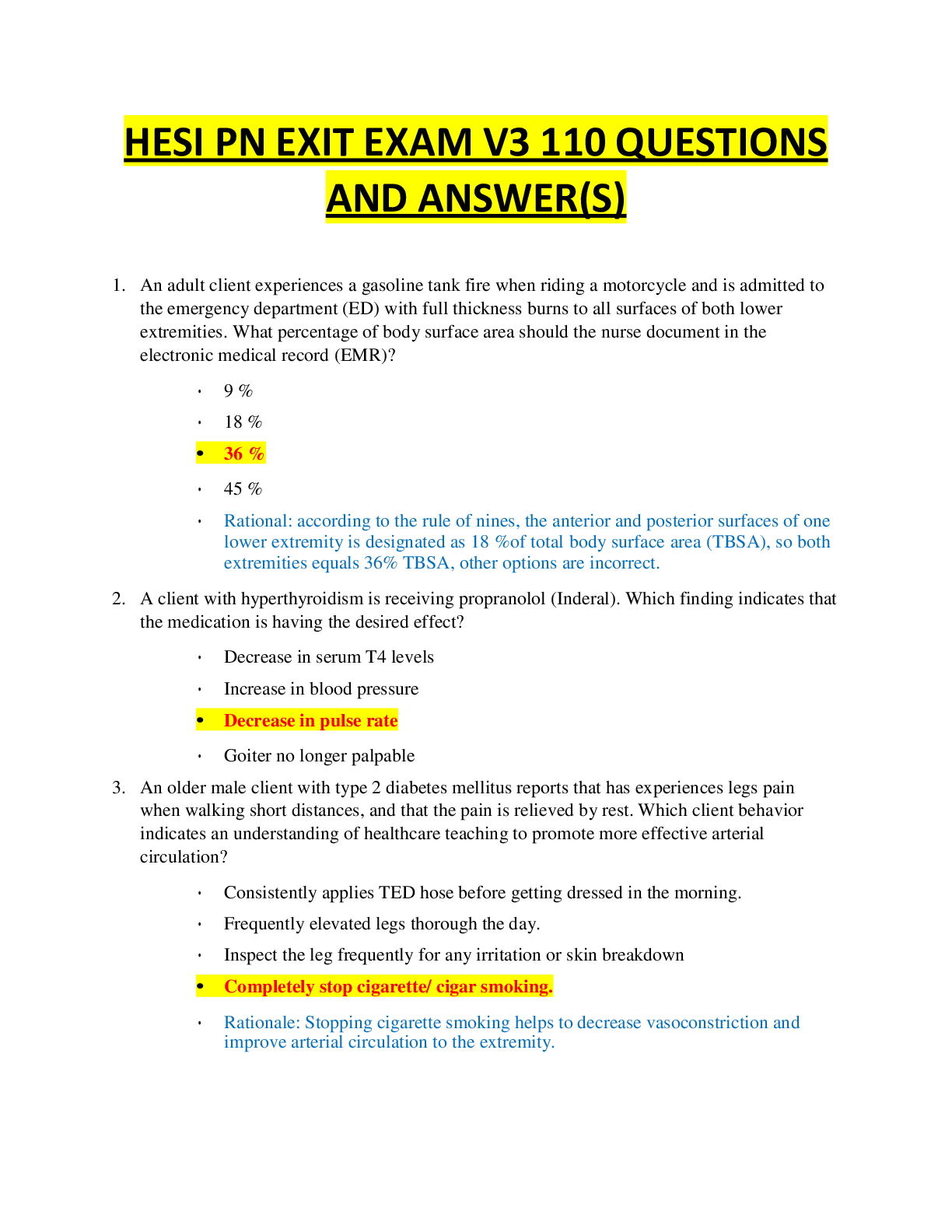
Reviews( 1 )

by [email protected] · 2 years ago
Document information
Connected school, study & course
About the document
Uploaded On
Oct 25, 2021
Number of pages
28
Written in
Additional information
This document has been written for:
Uploaded
Oct 25, 2021
Downloads
1
Views
96
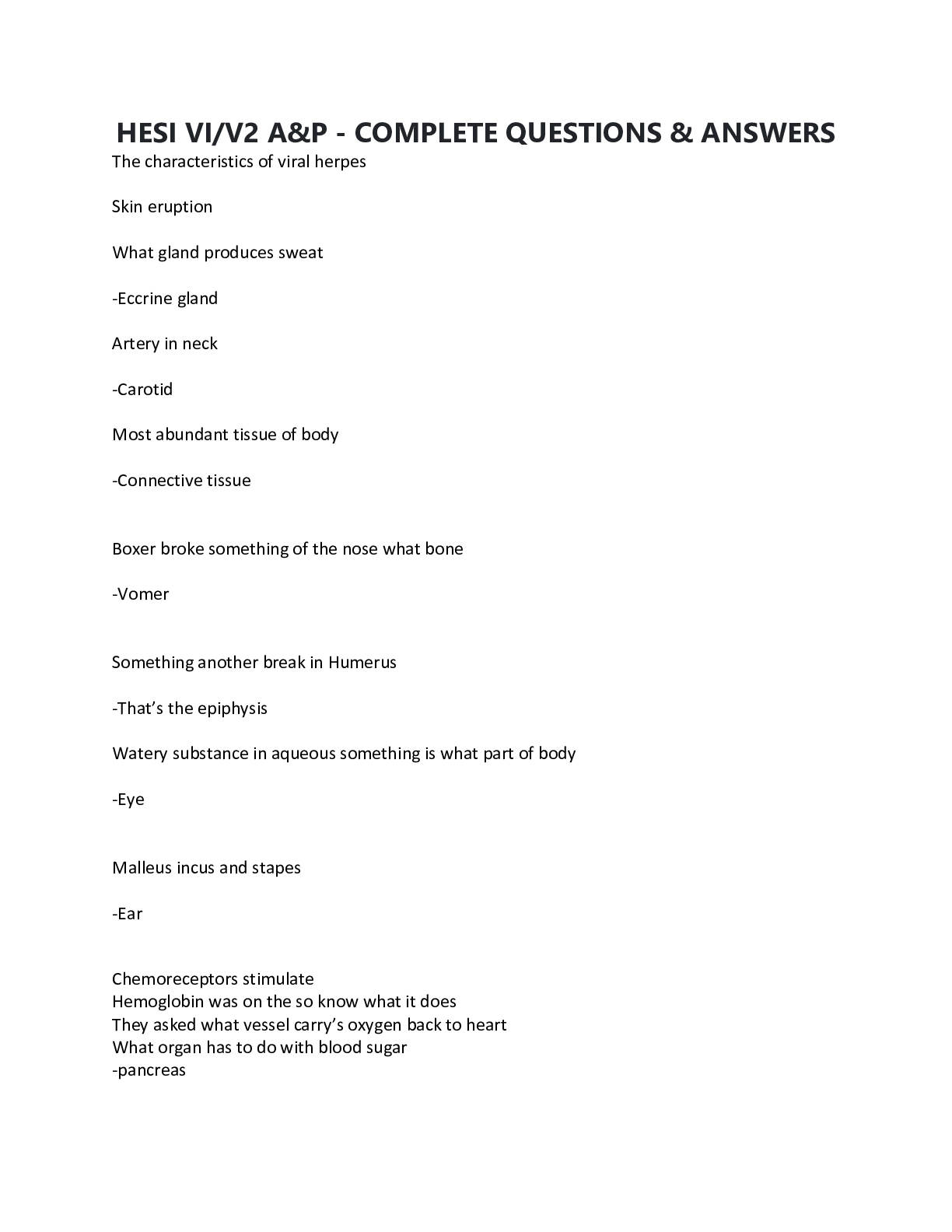

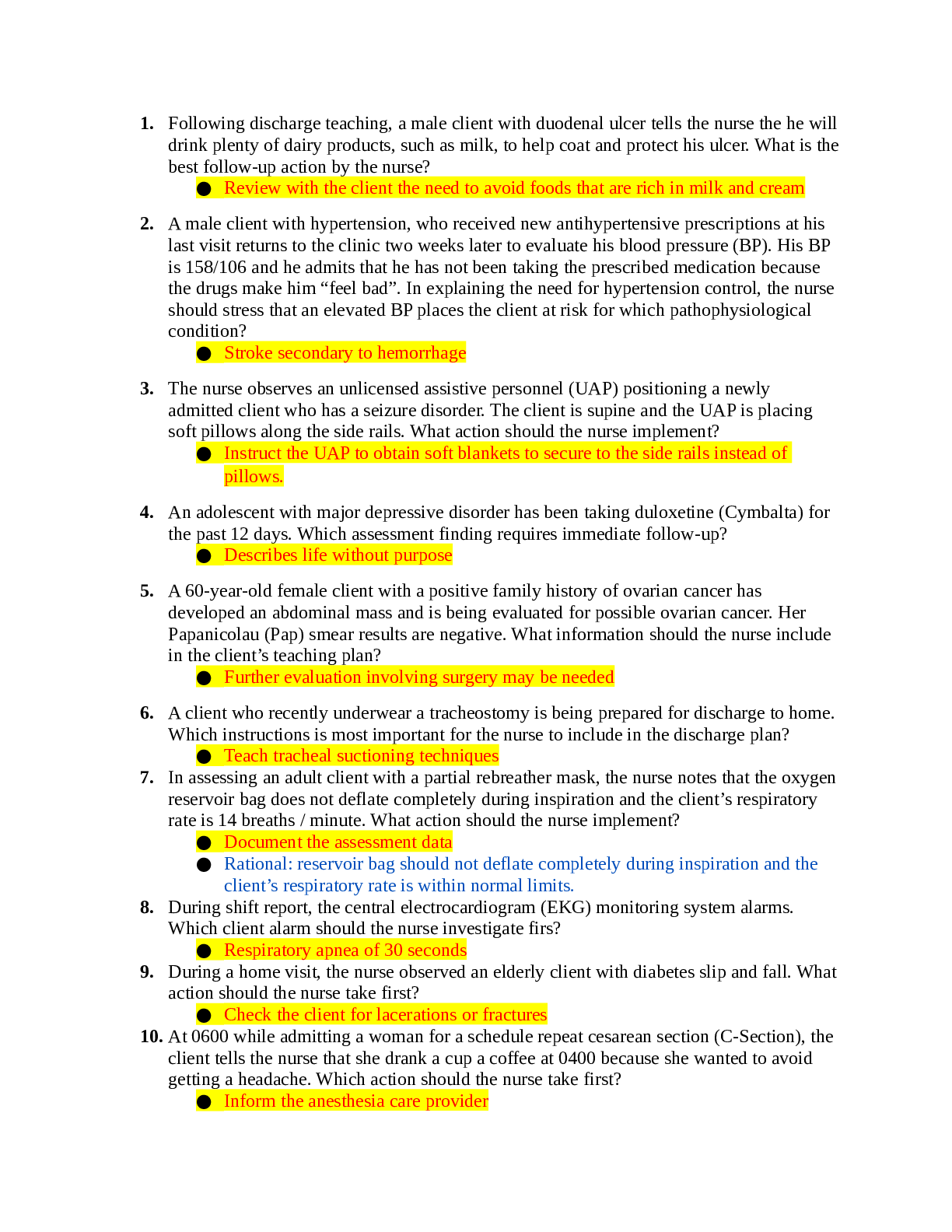
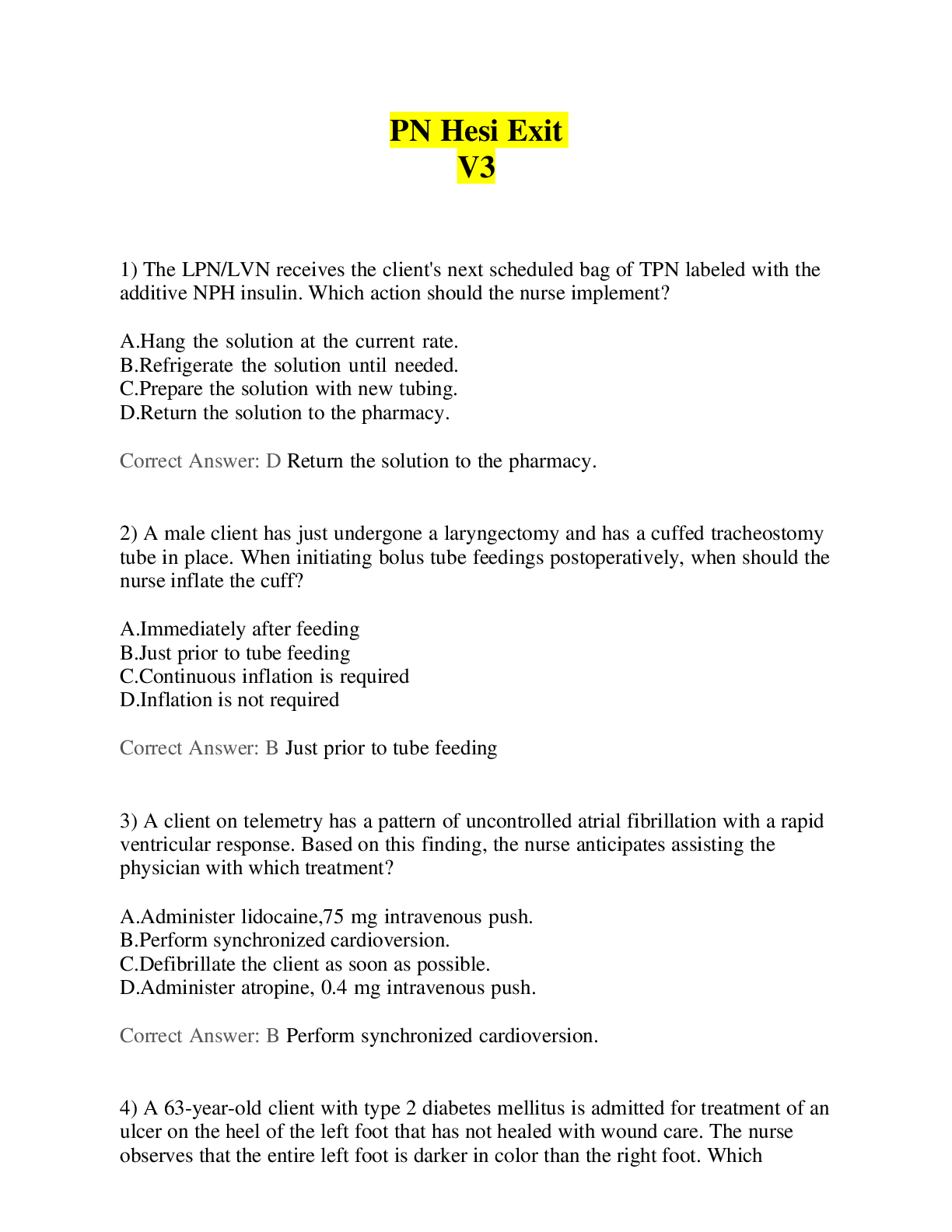
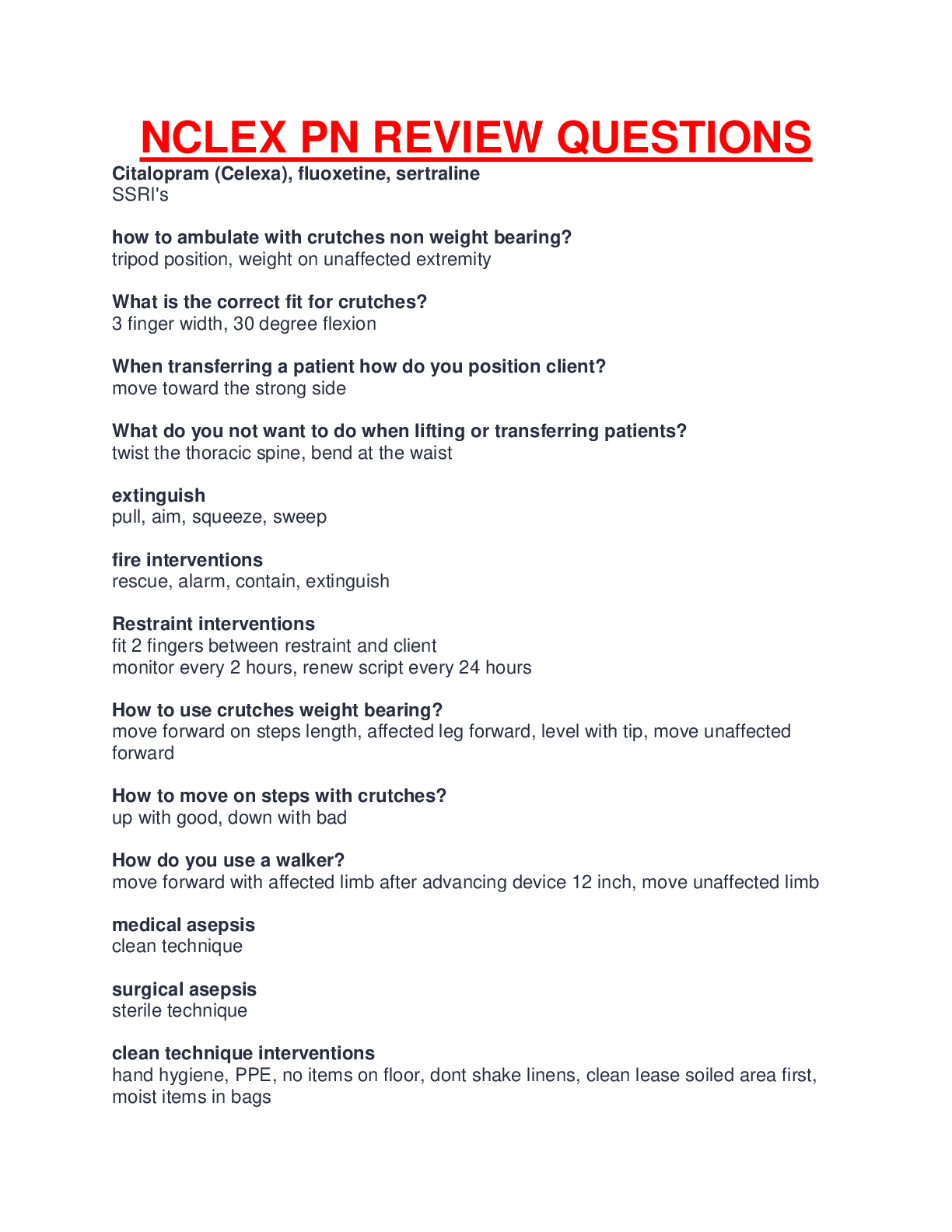
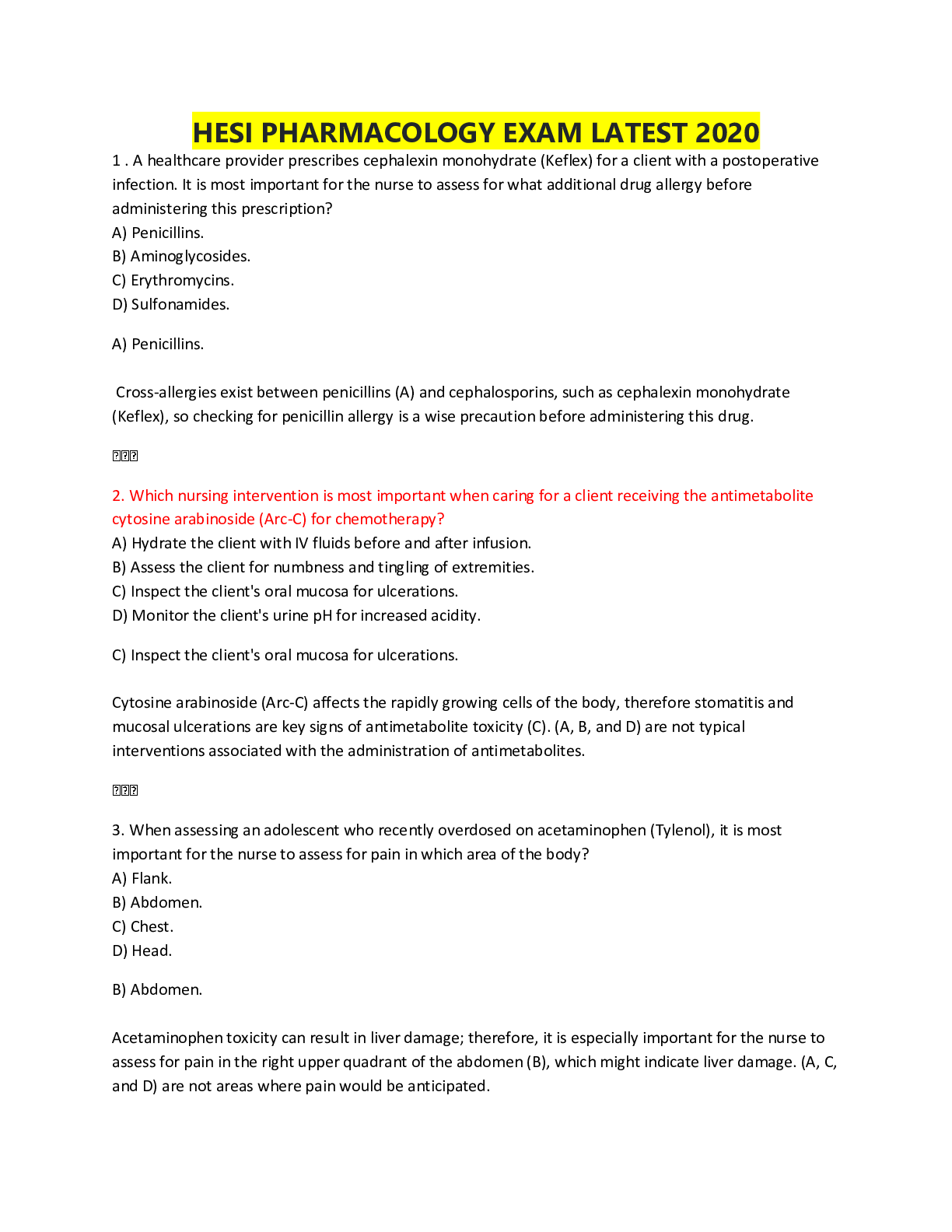
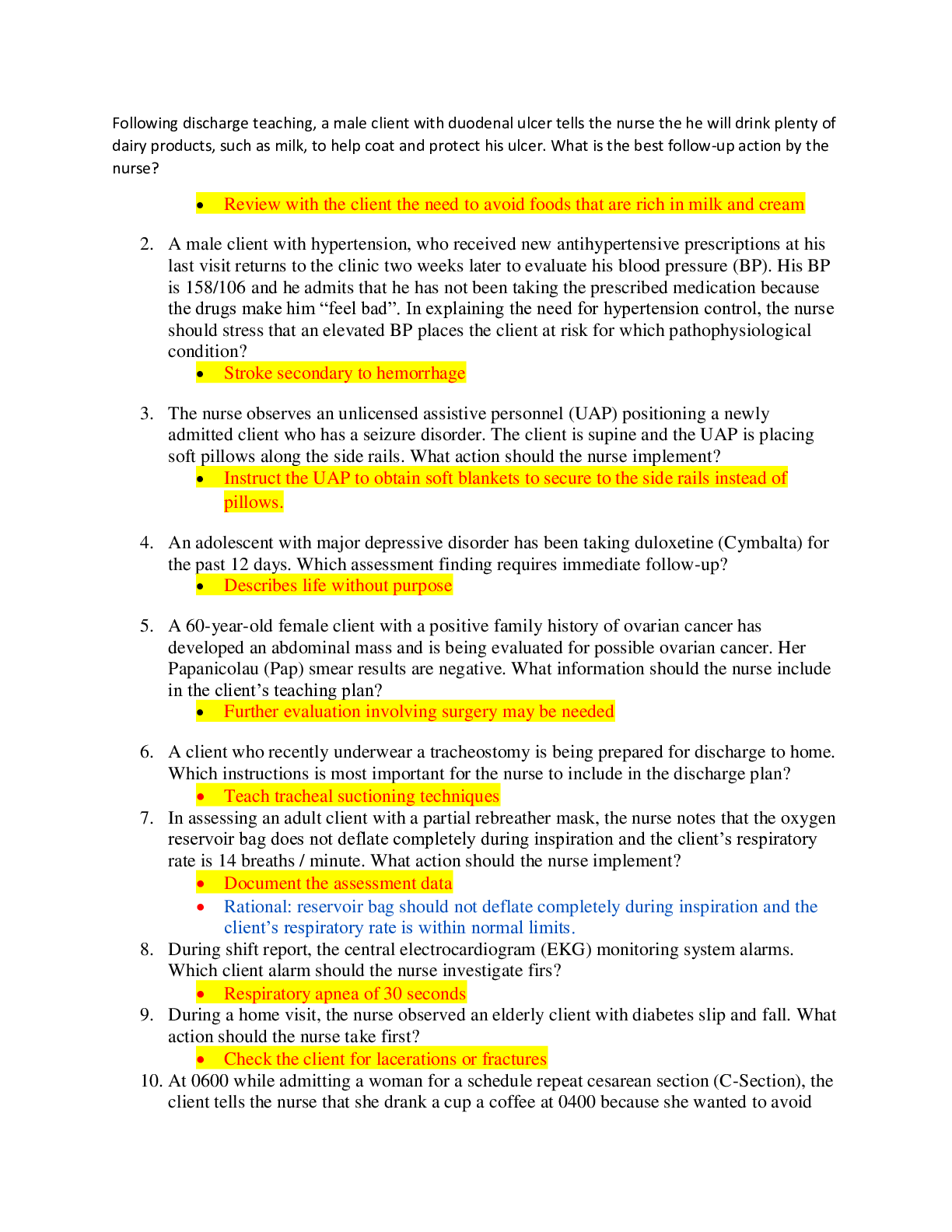
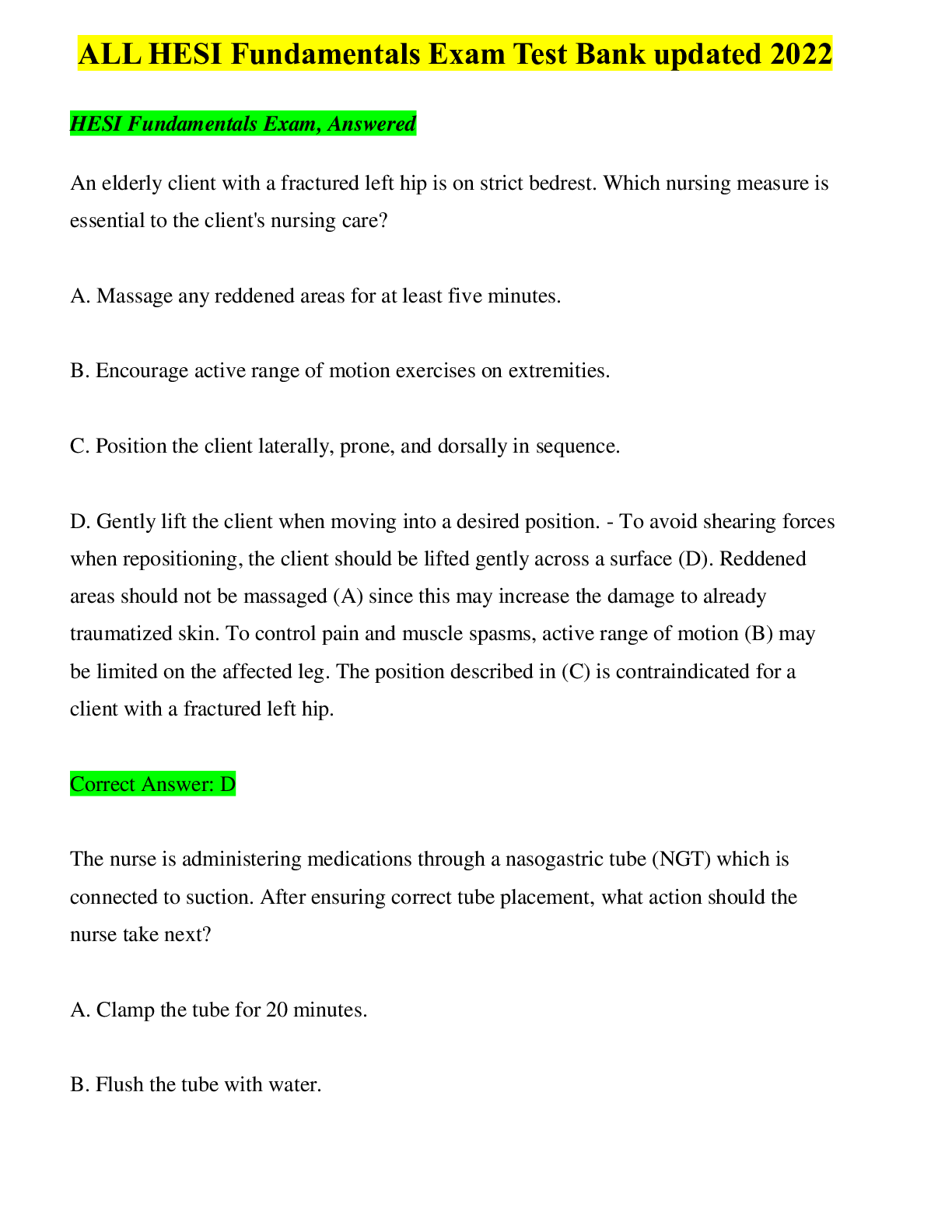

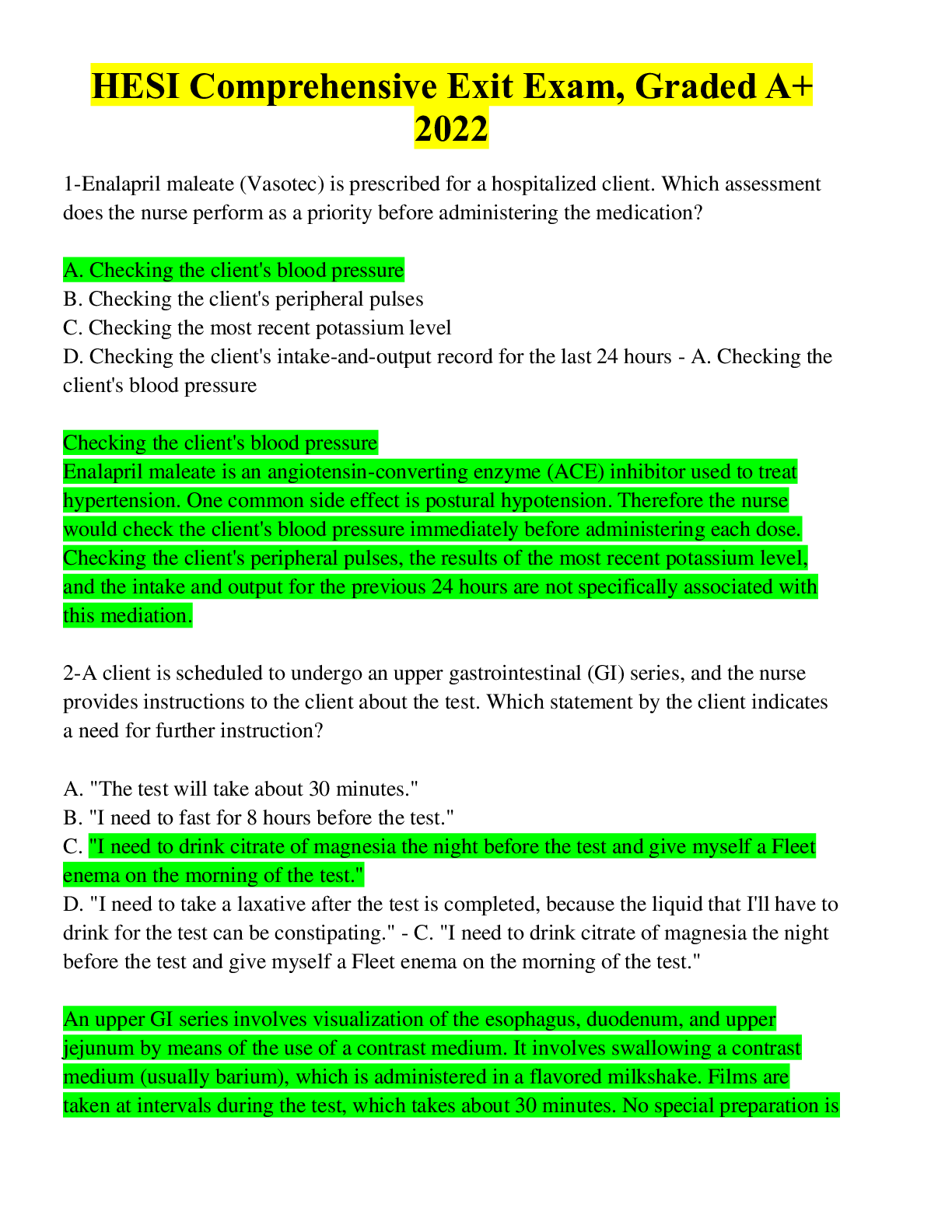

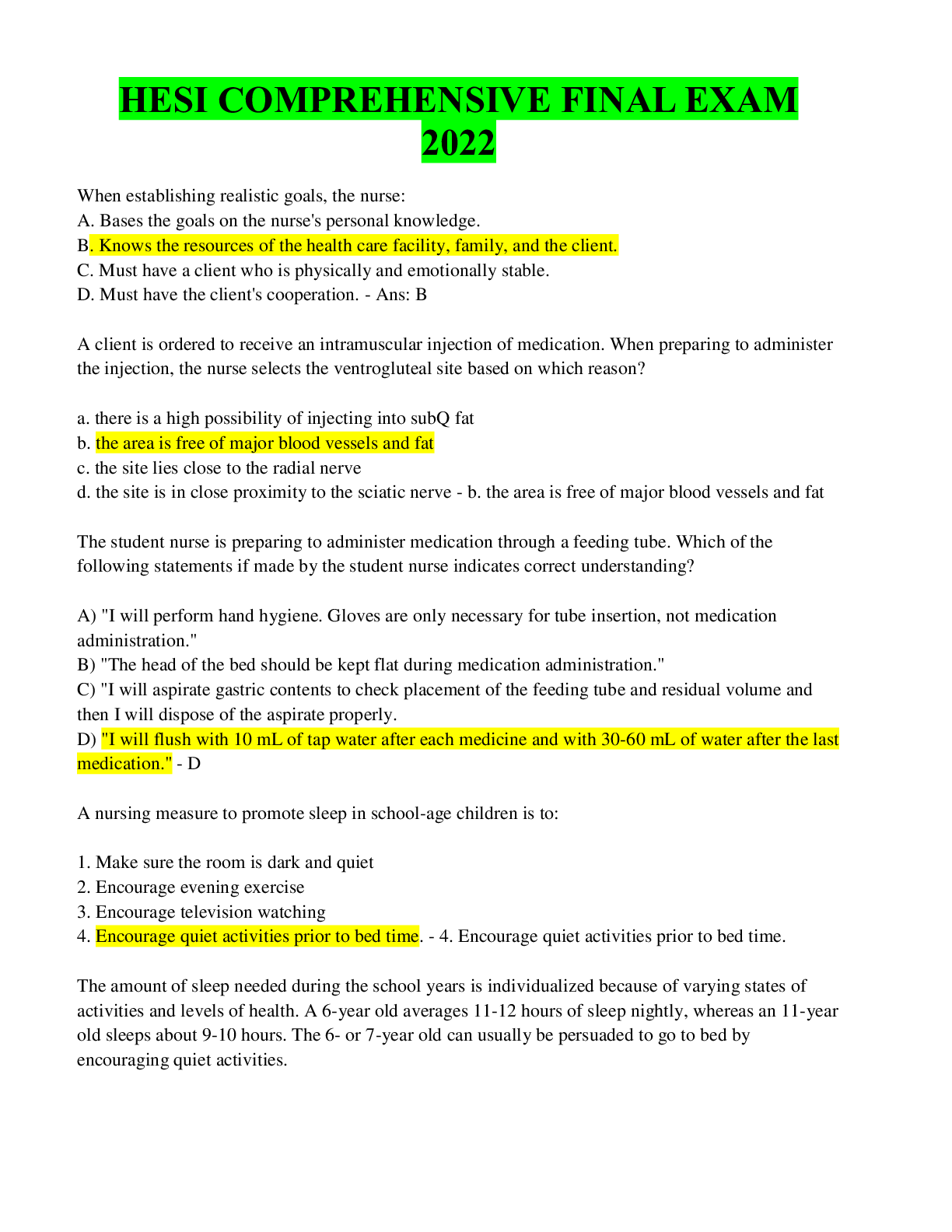
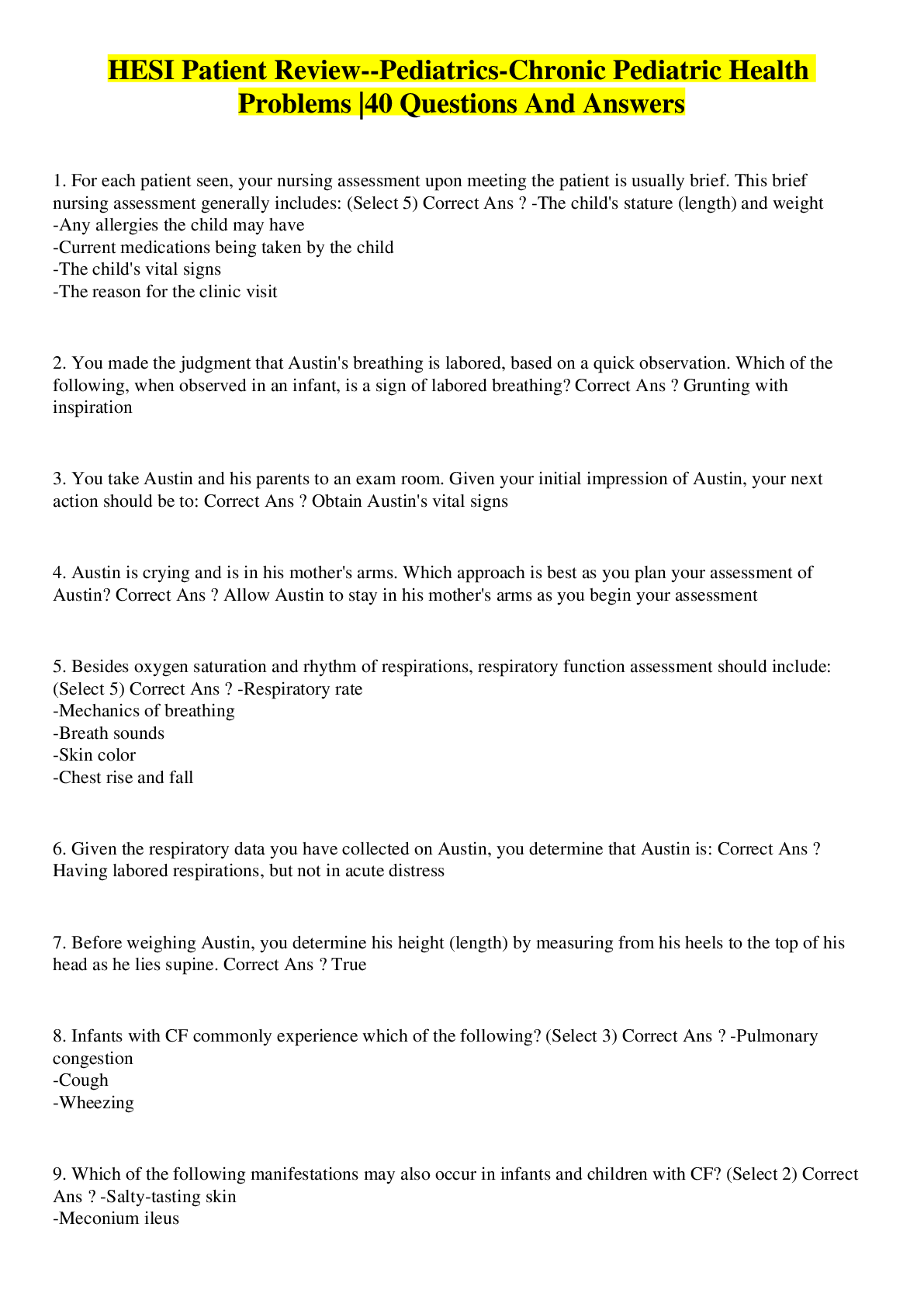
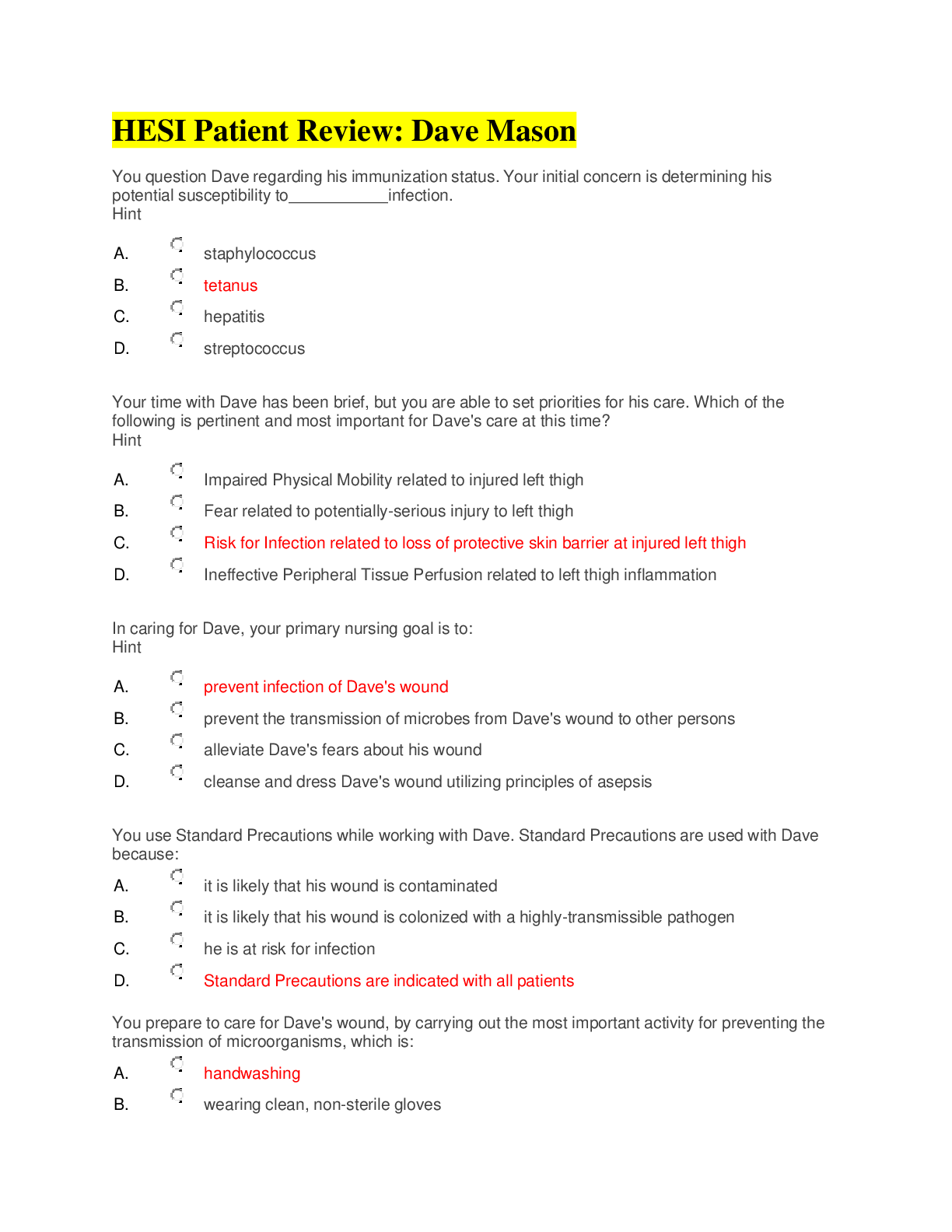



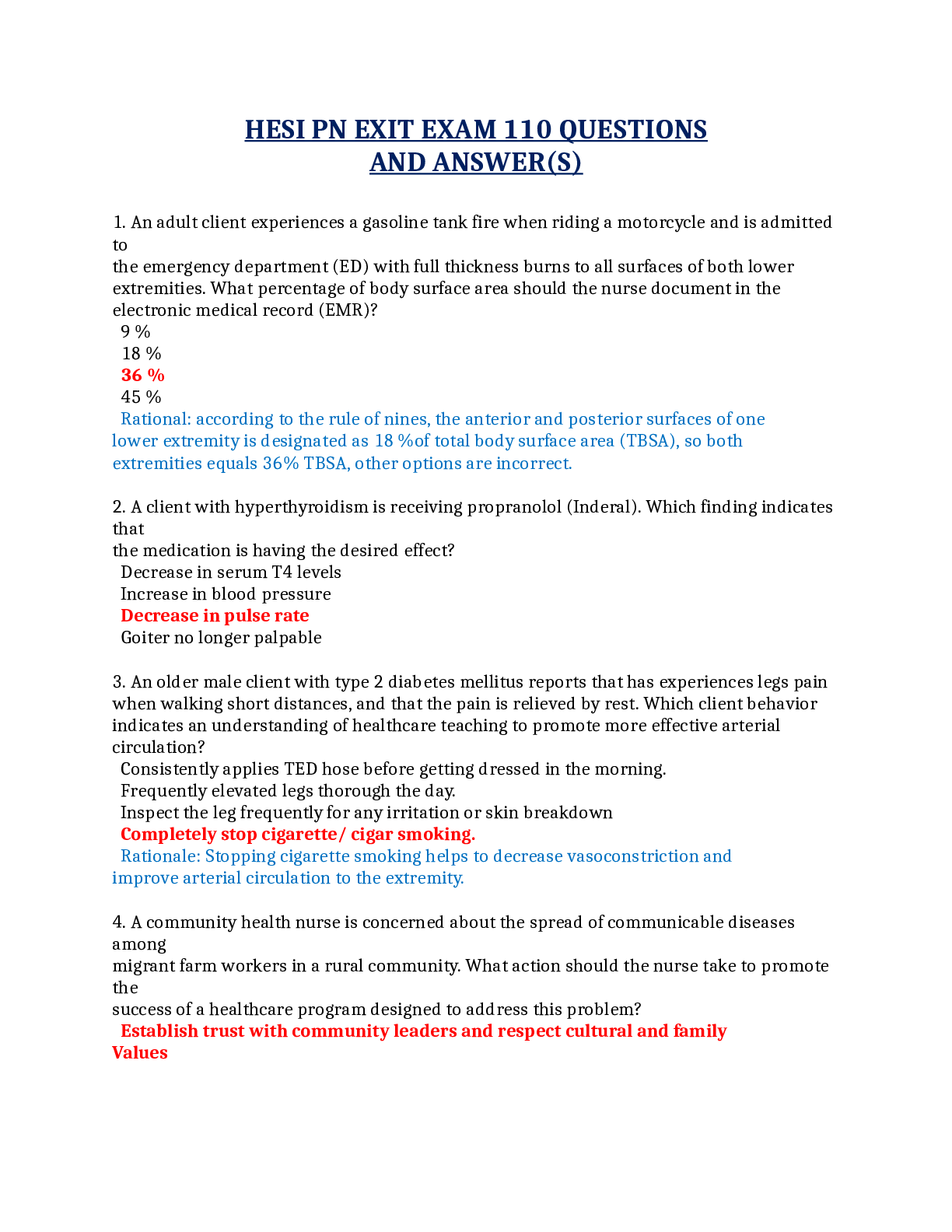

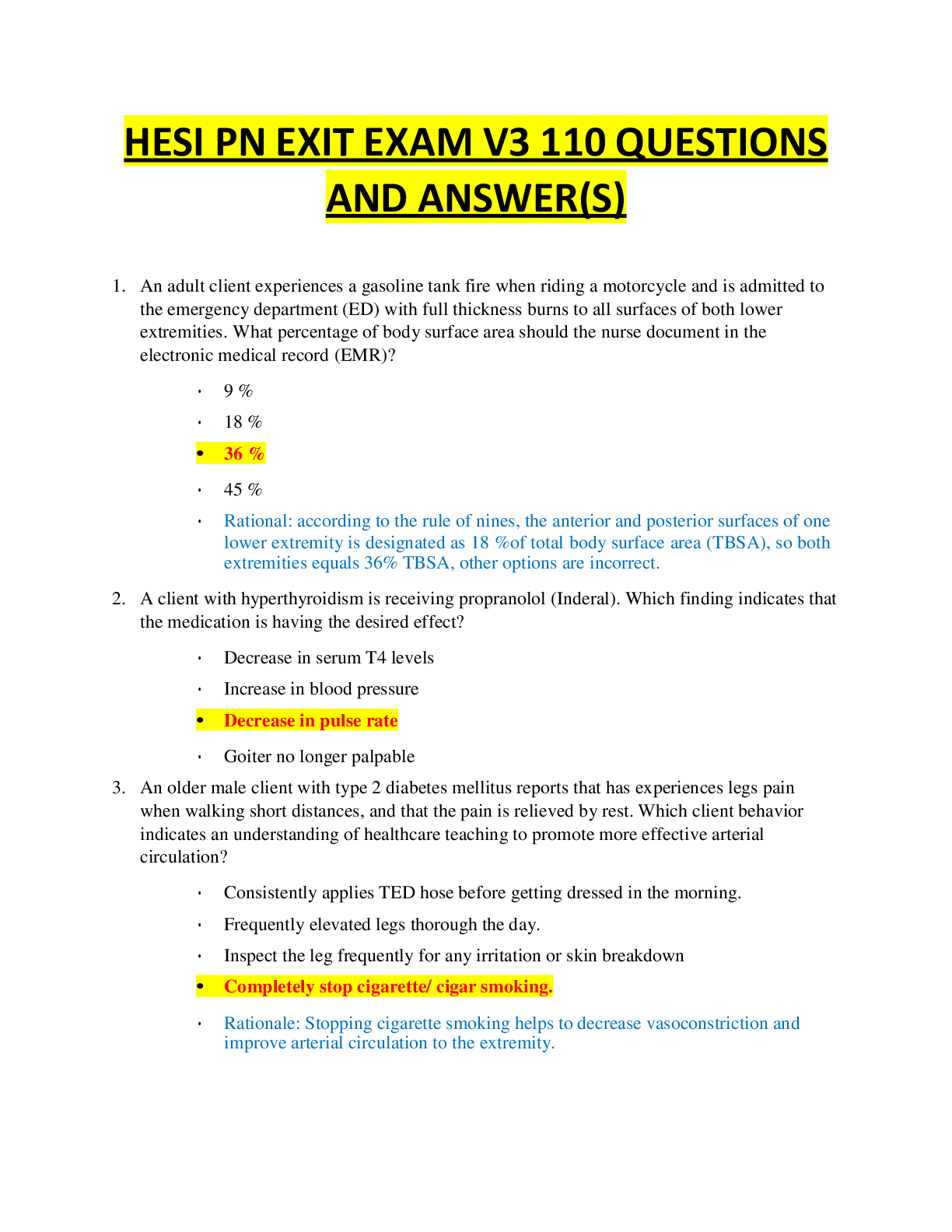
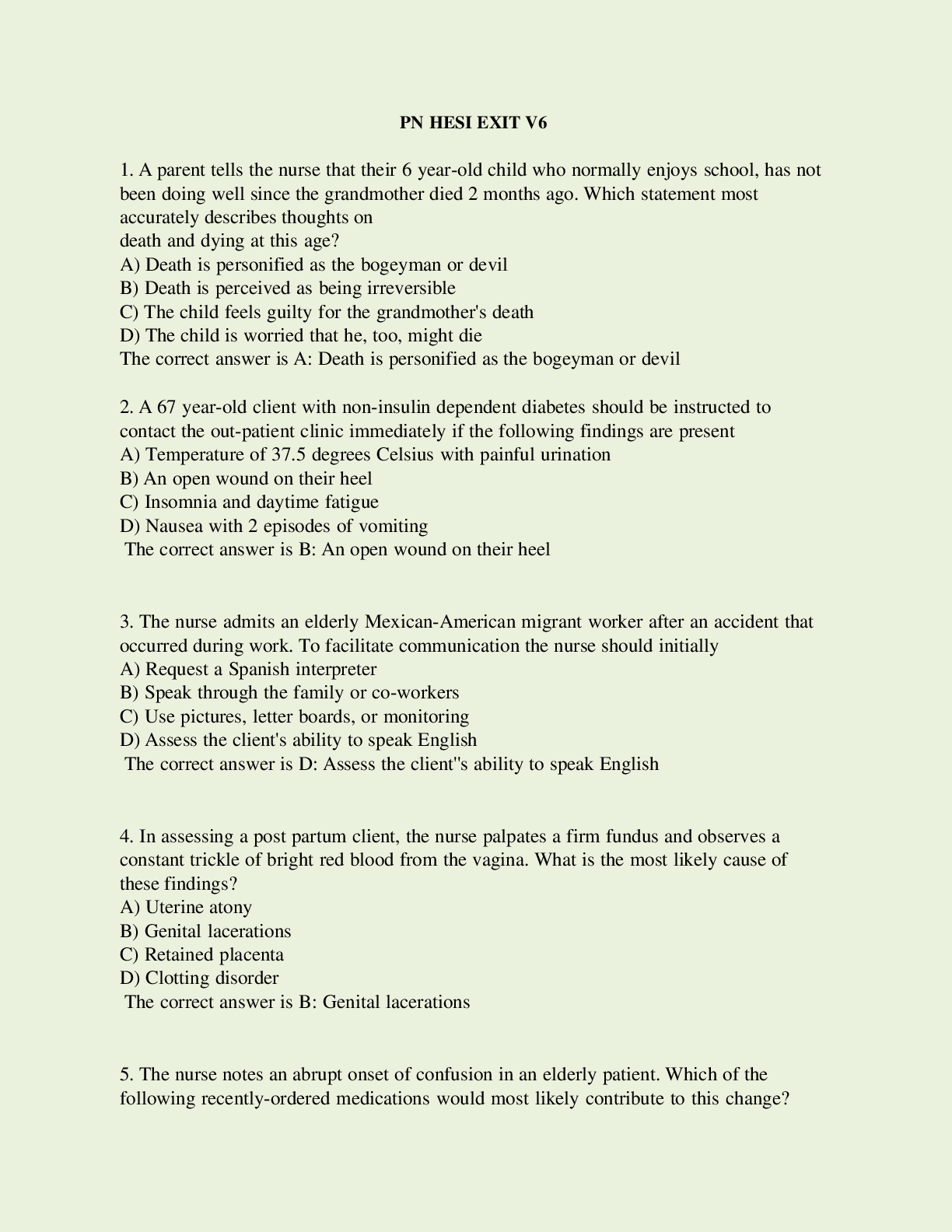
 100 QUESTIONS AND ANSWER(S) WITH RATIONALE TEST PREP GUIDE GRADED A+.png)
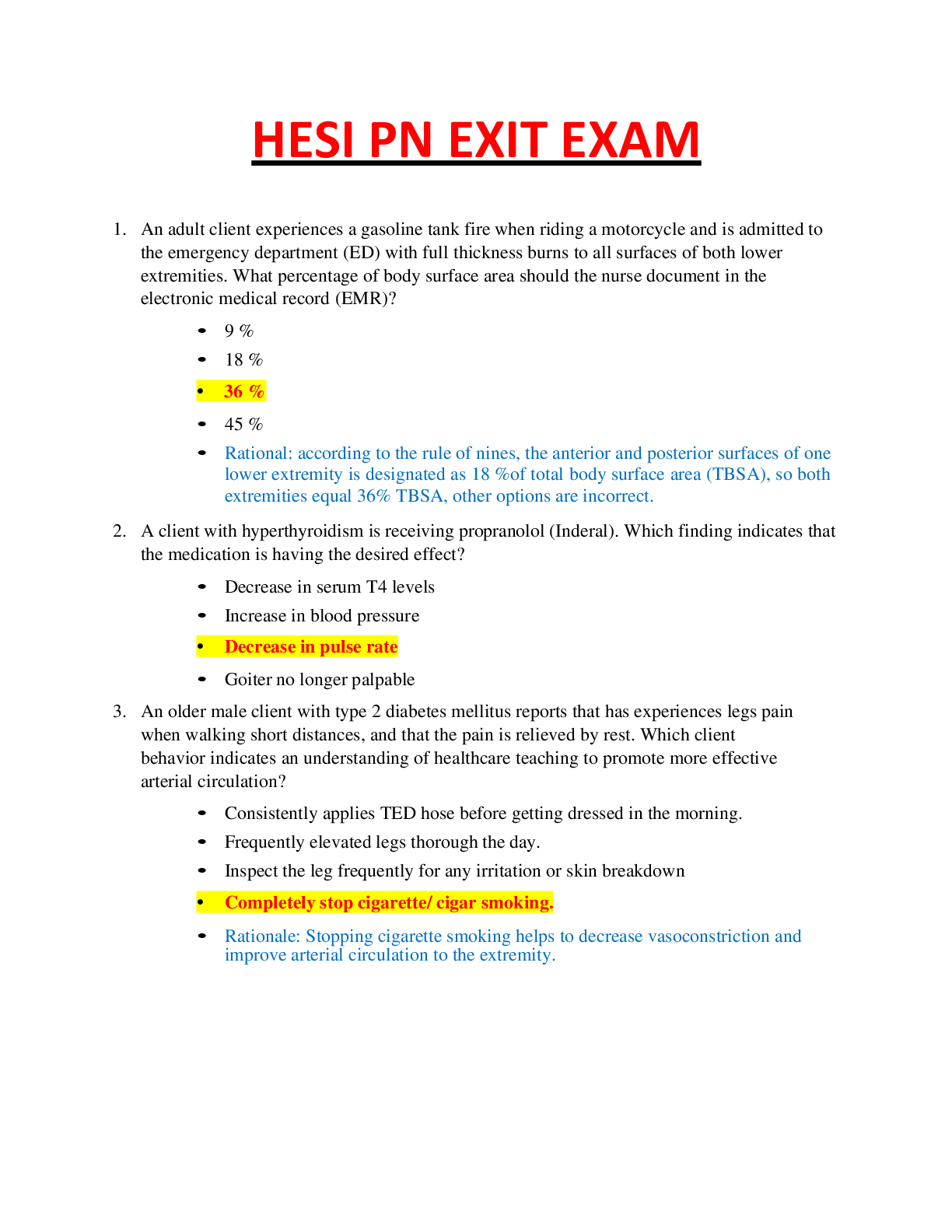
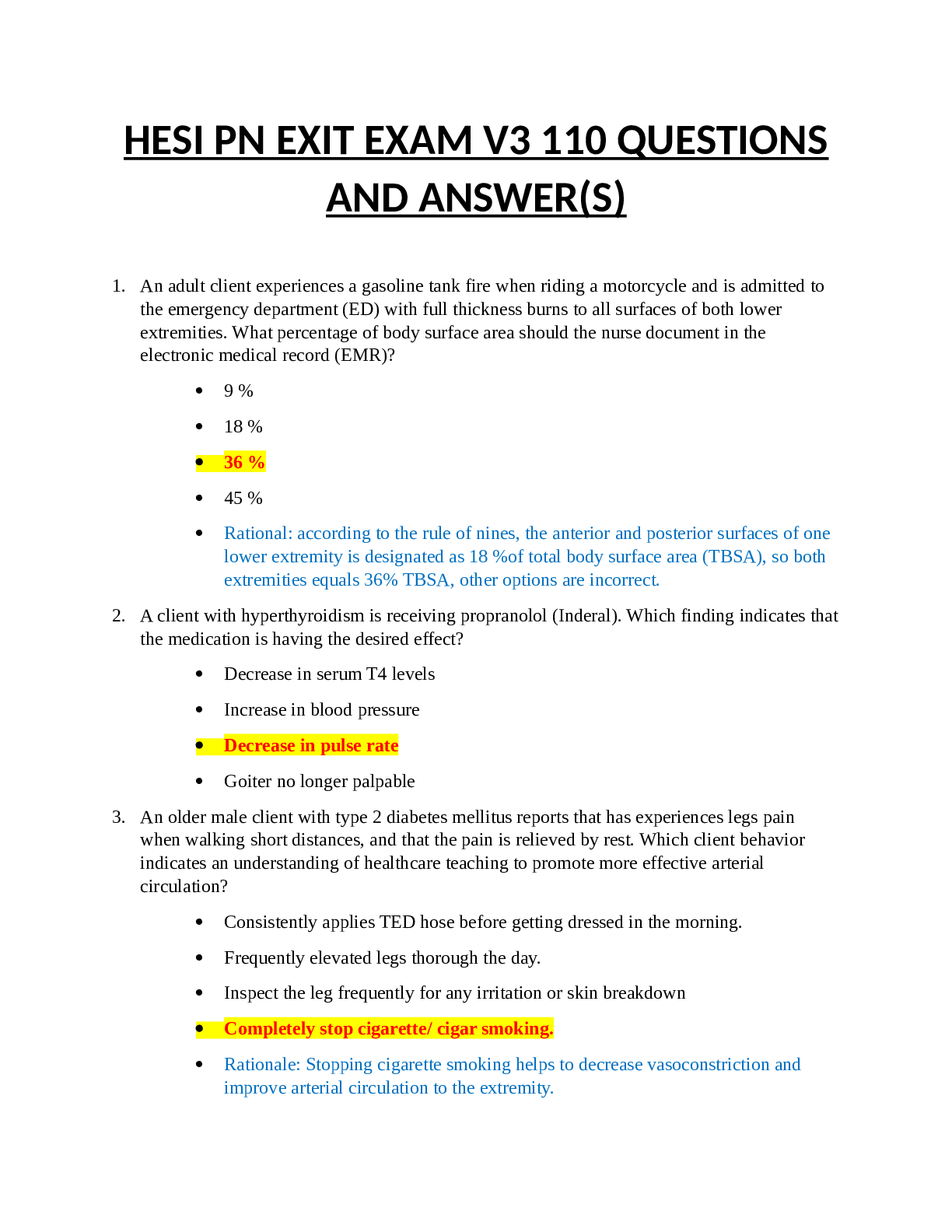
.png)
